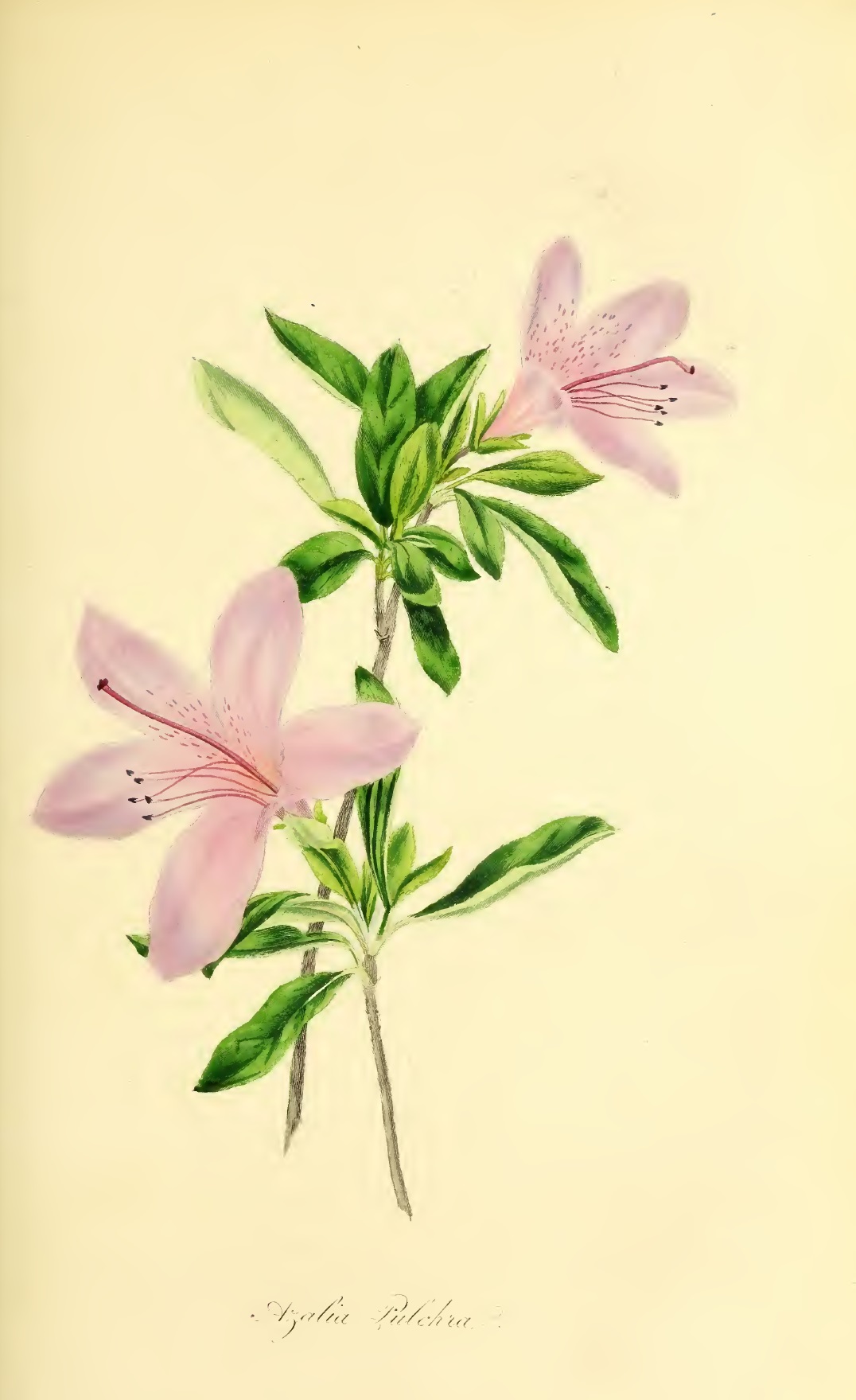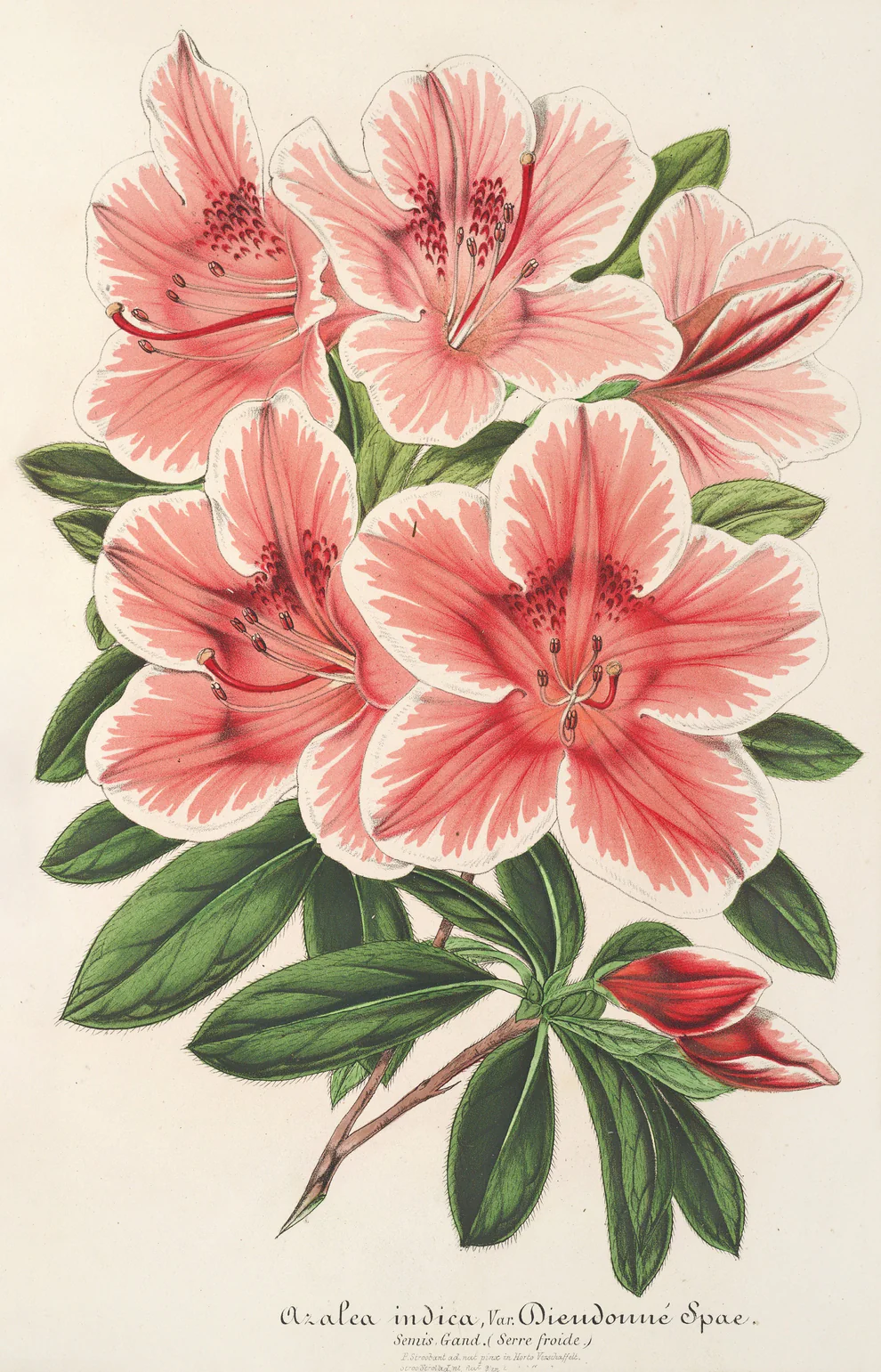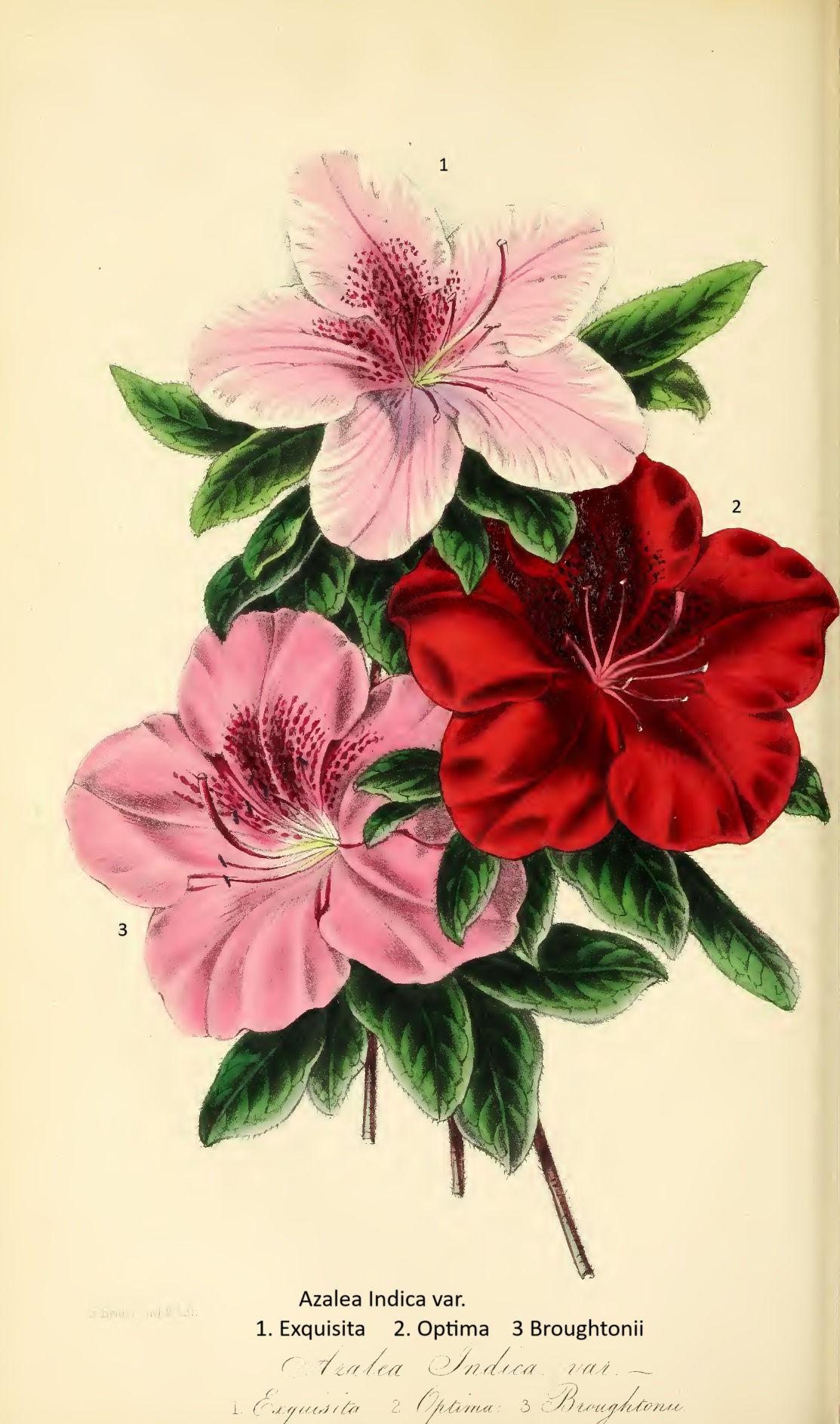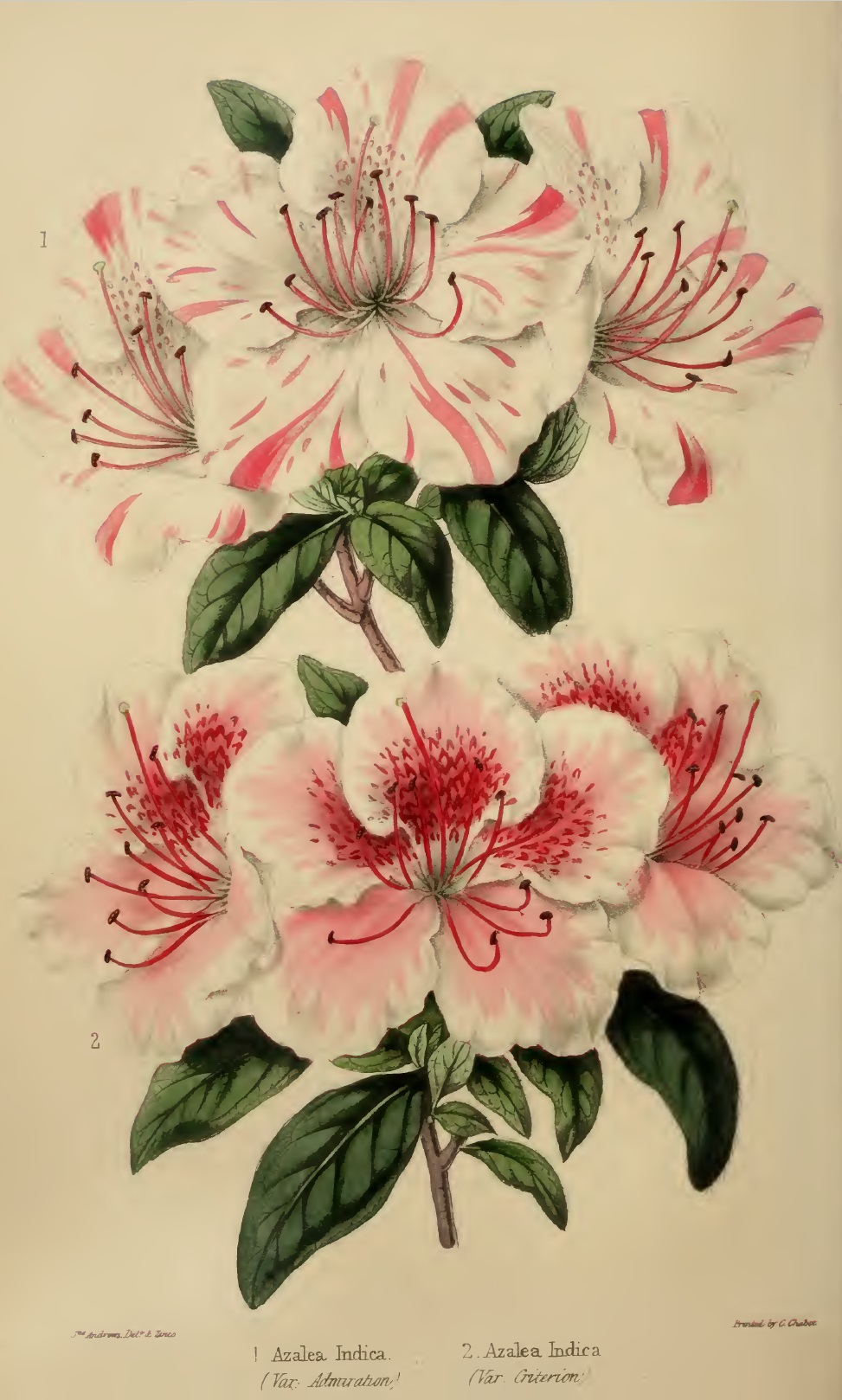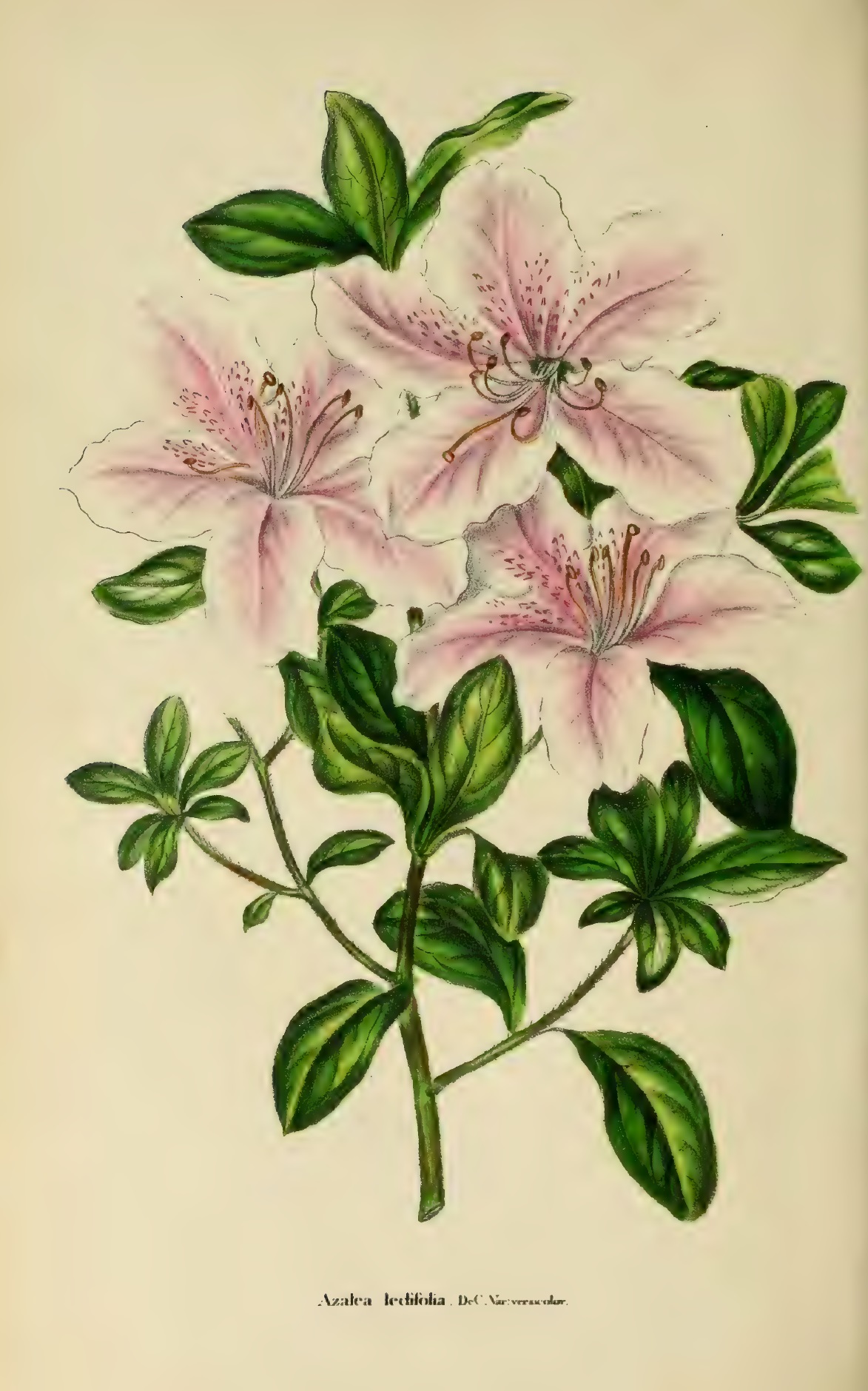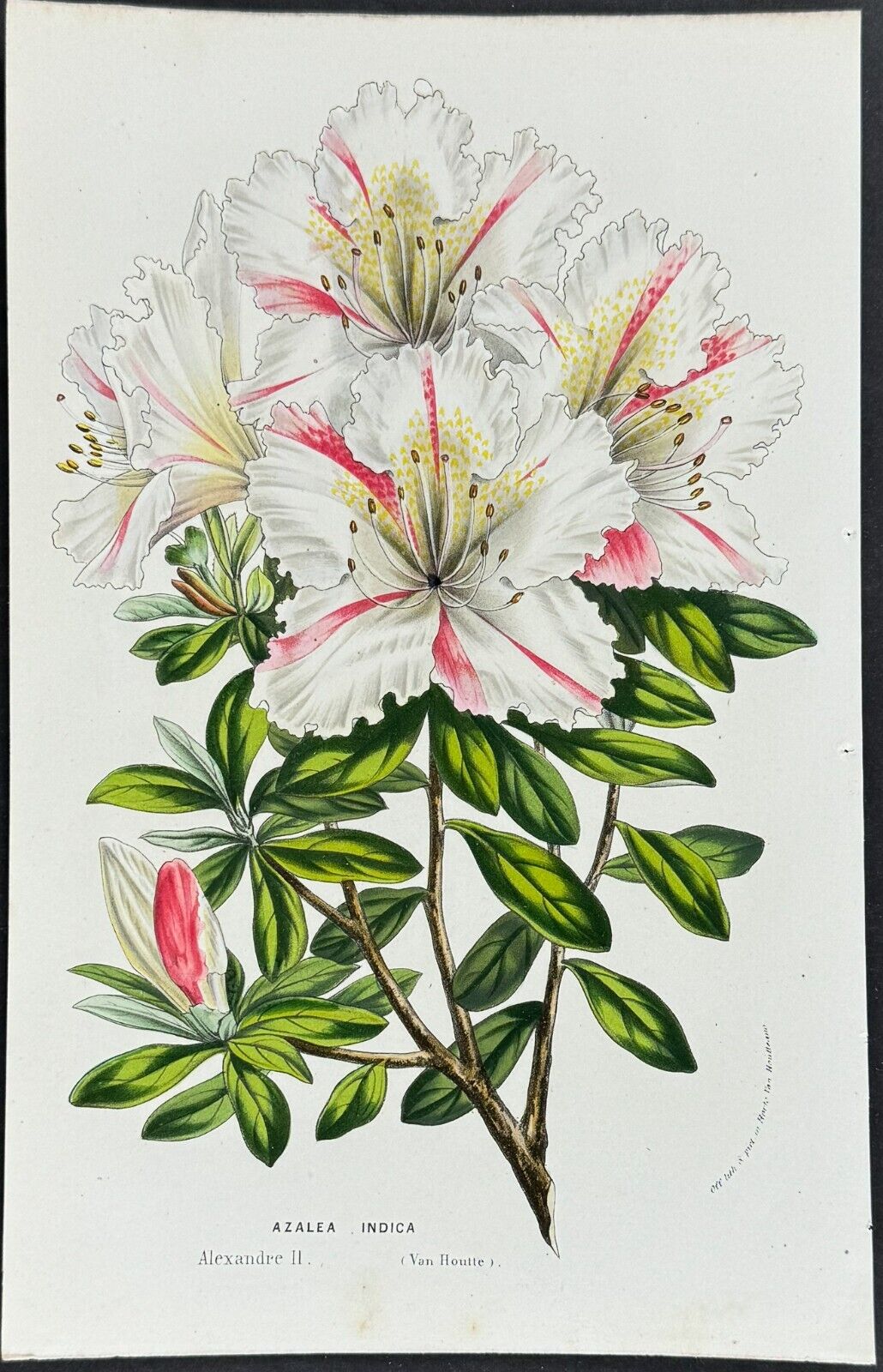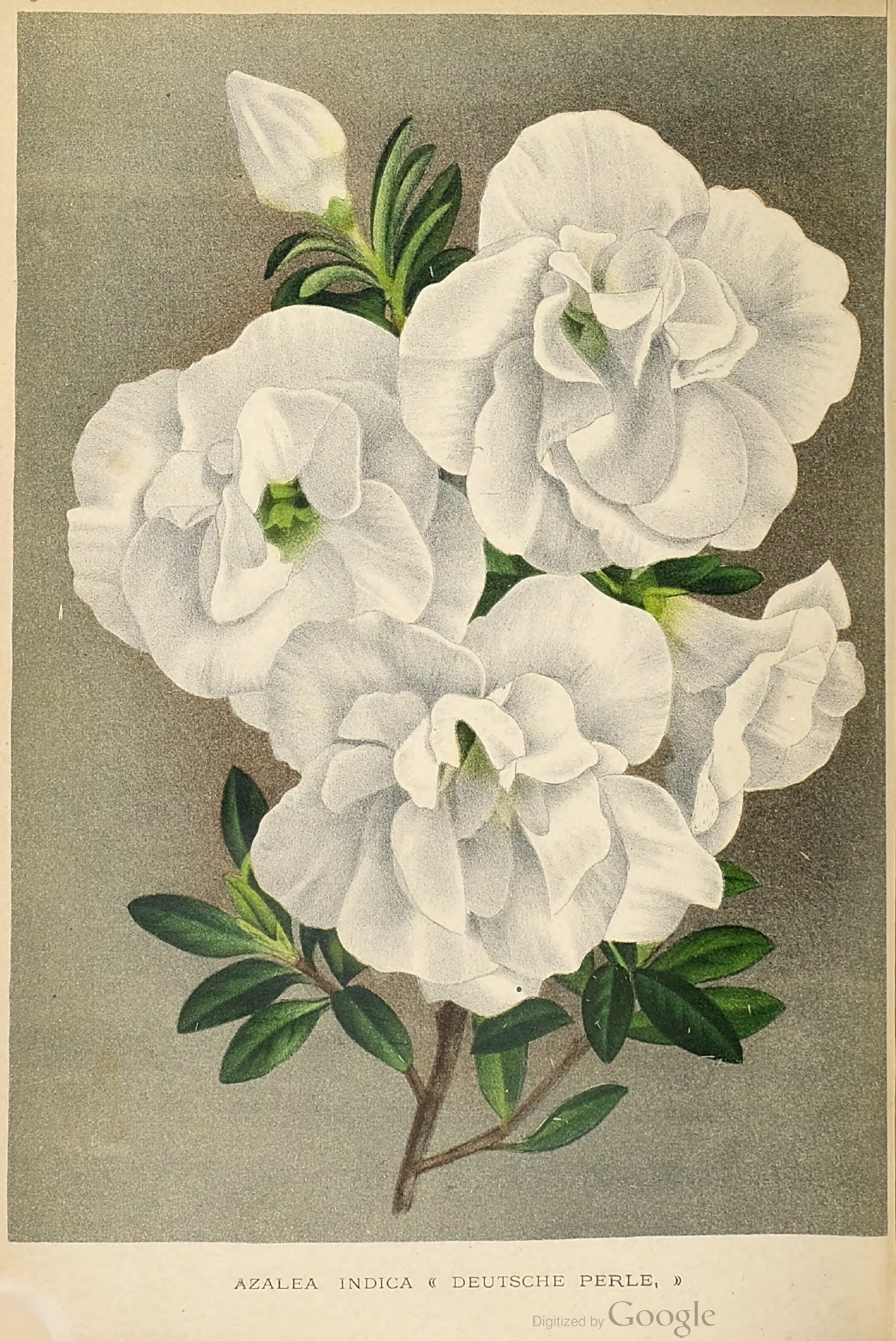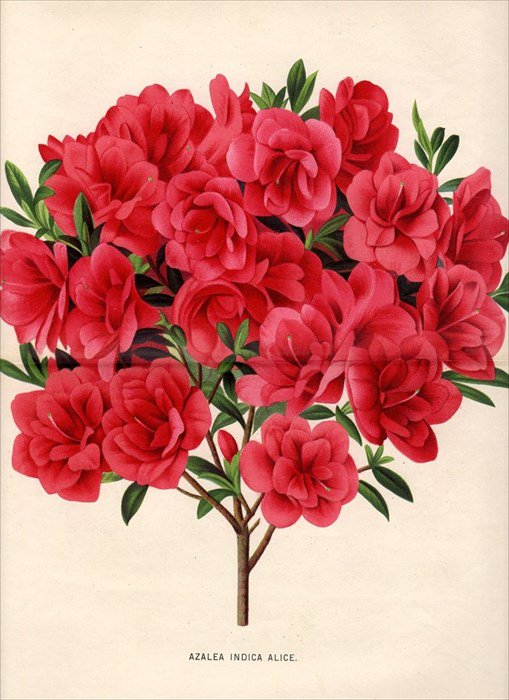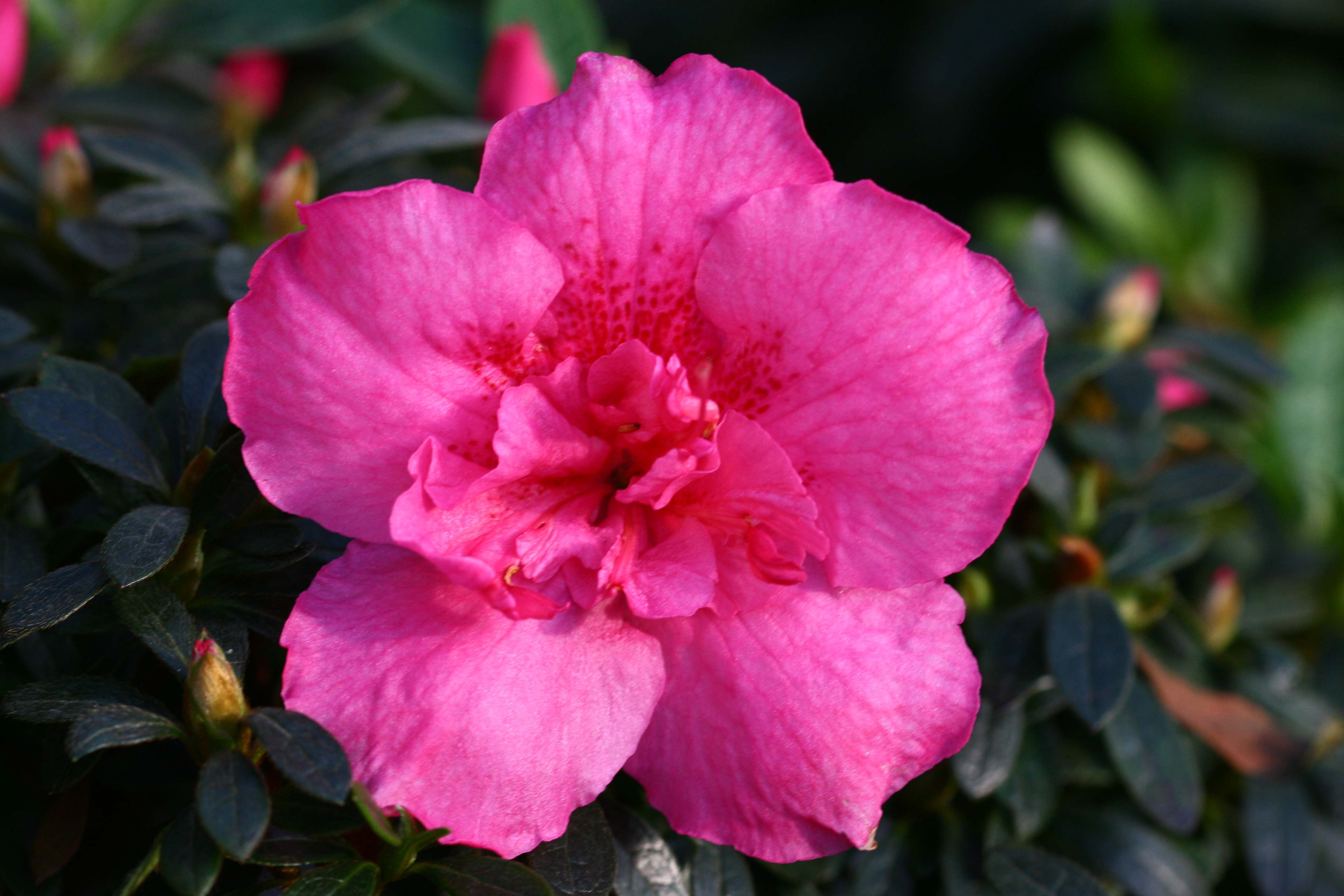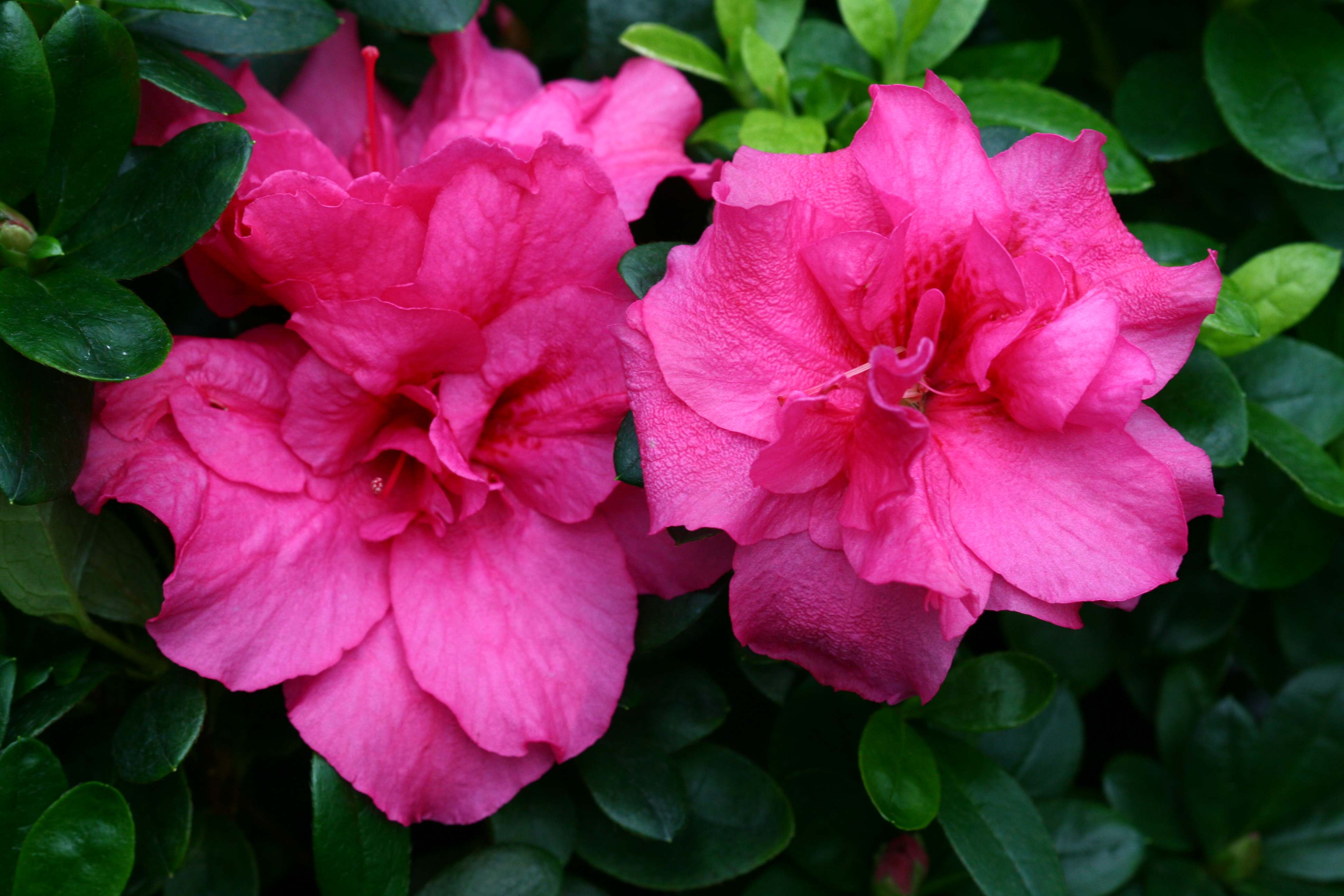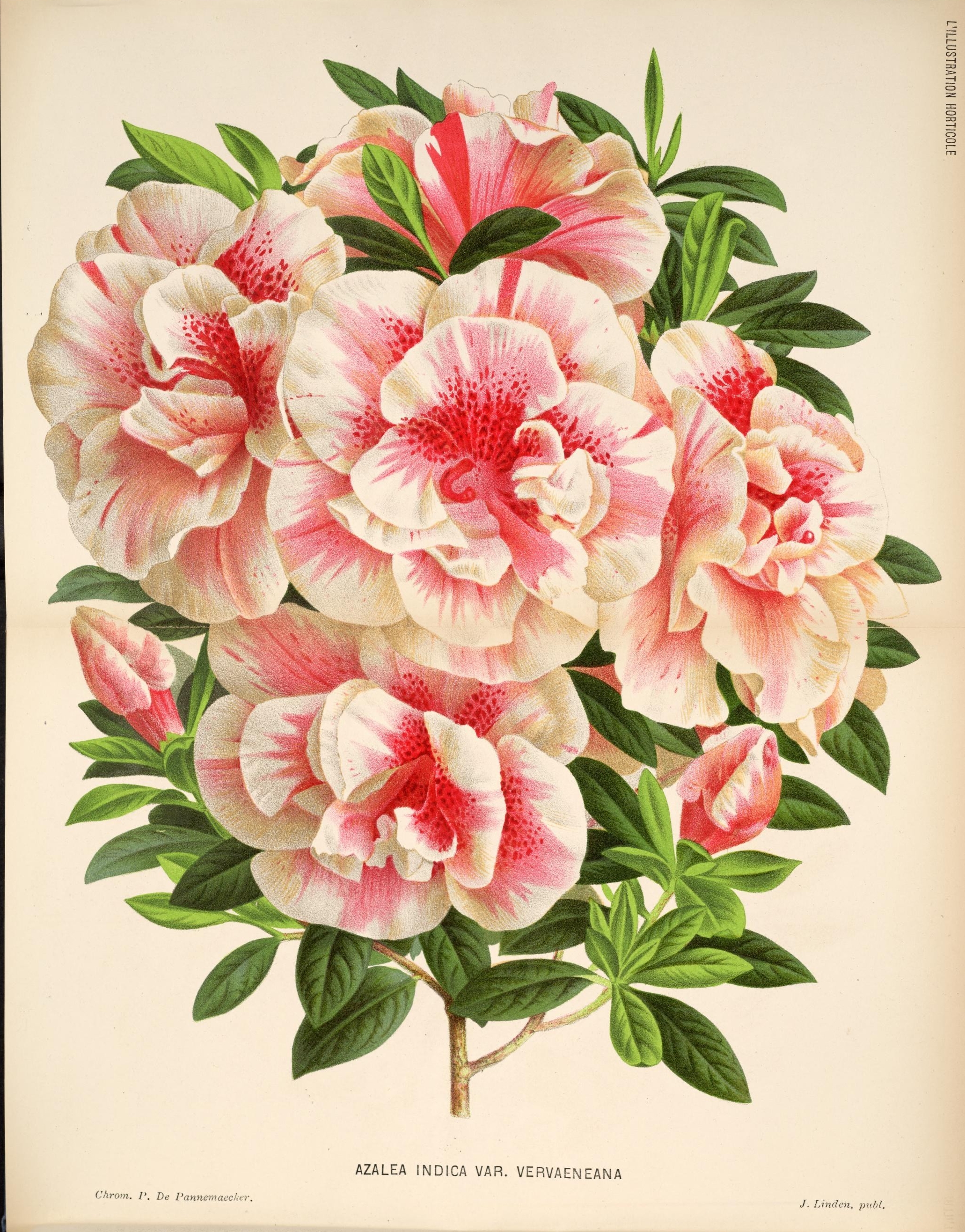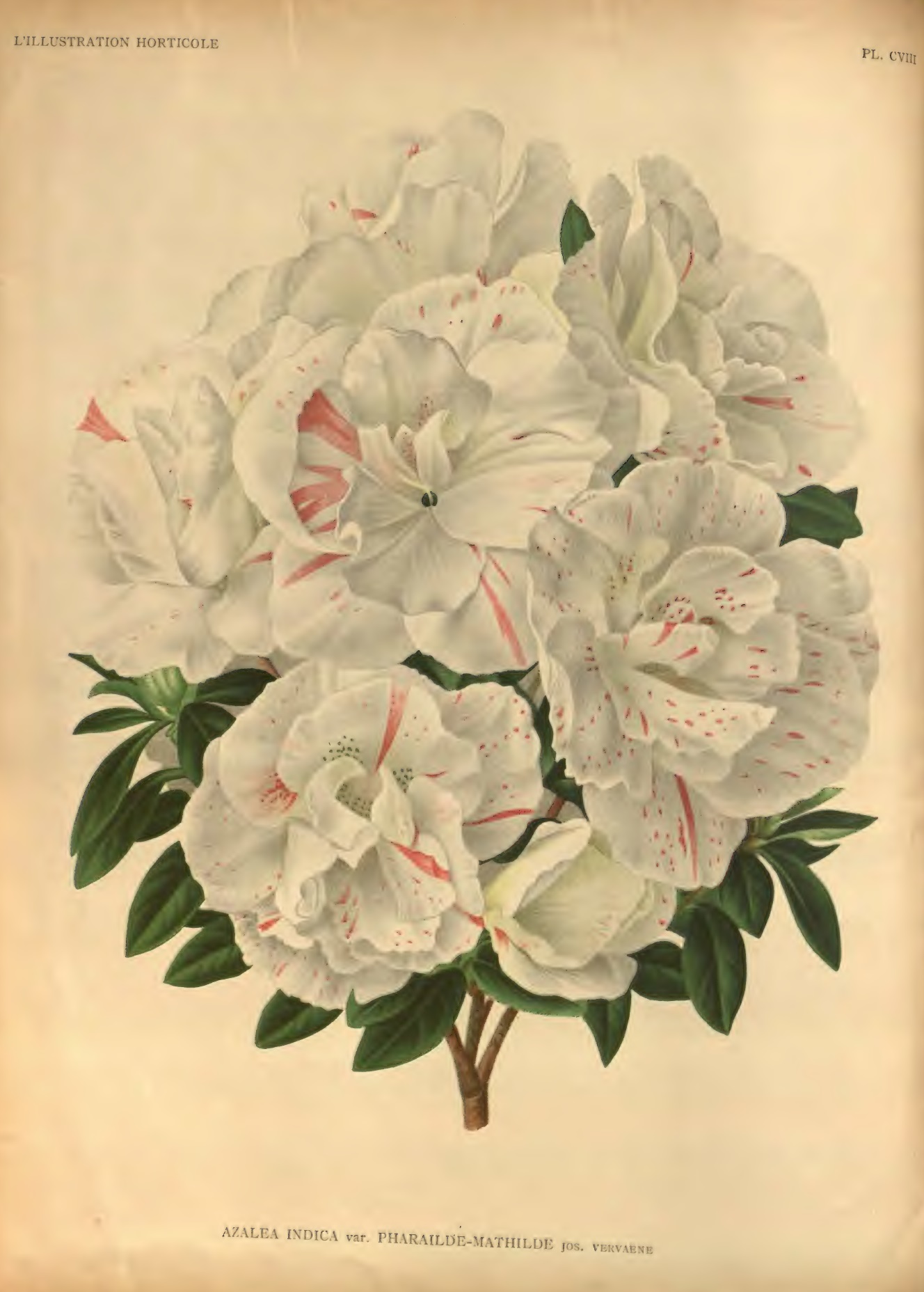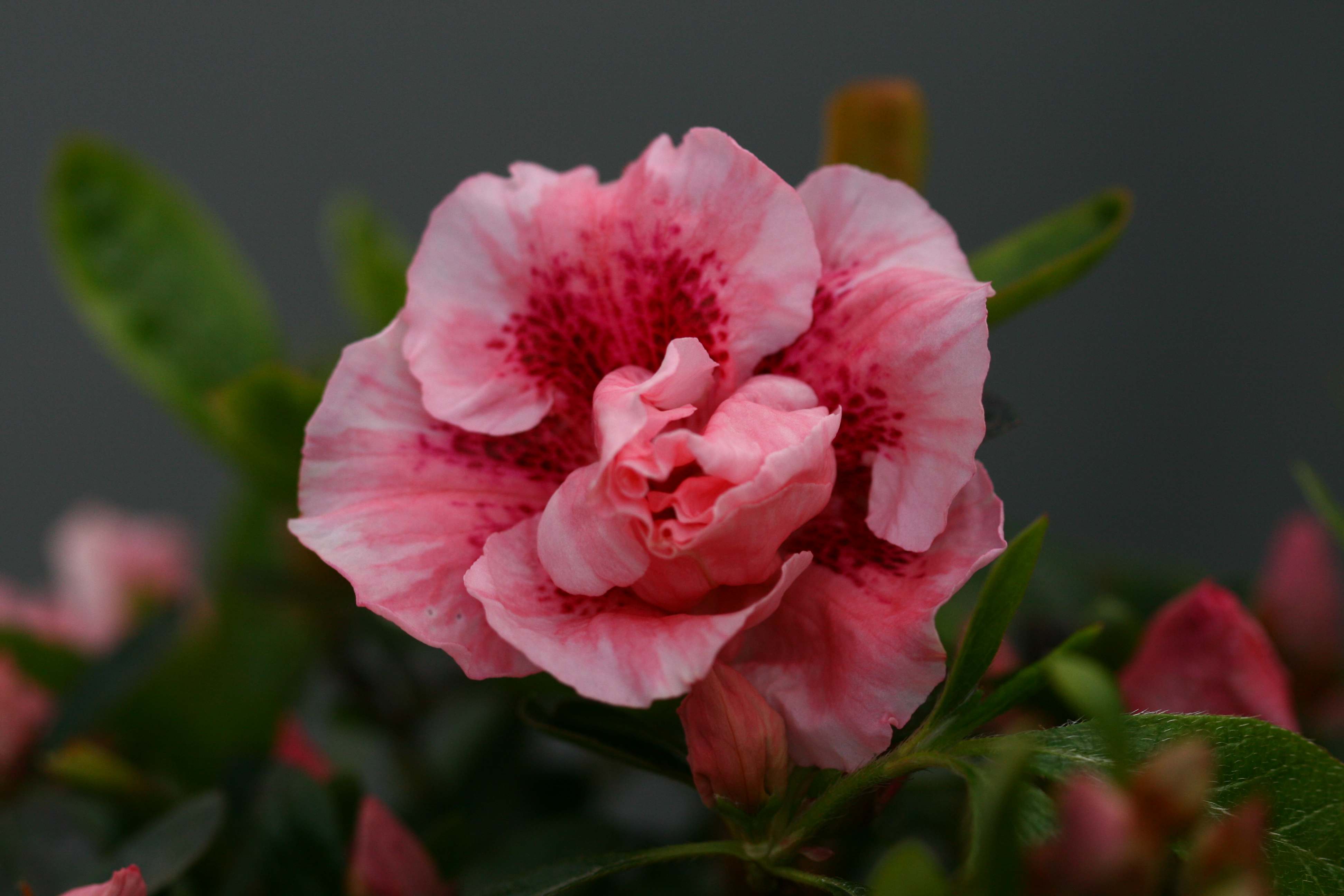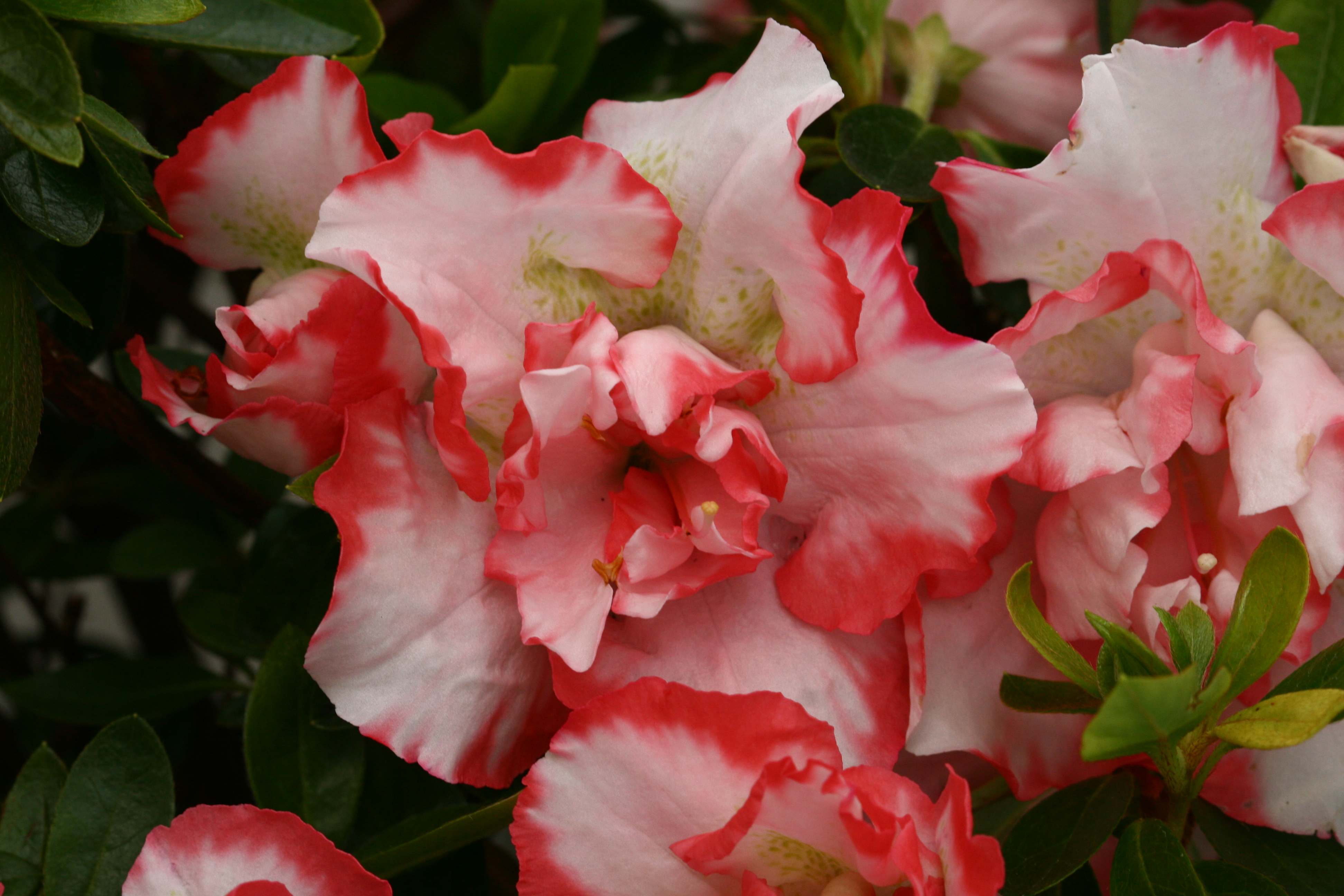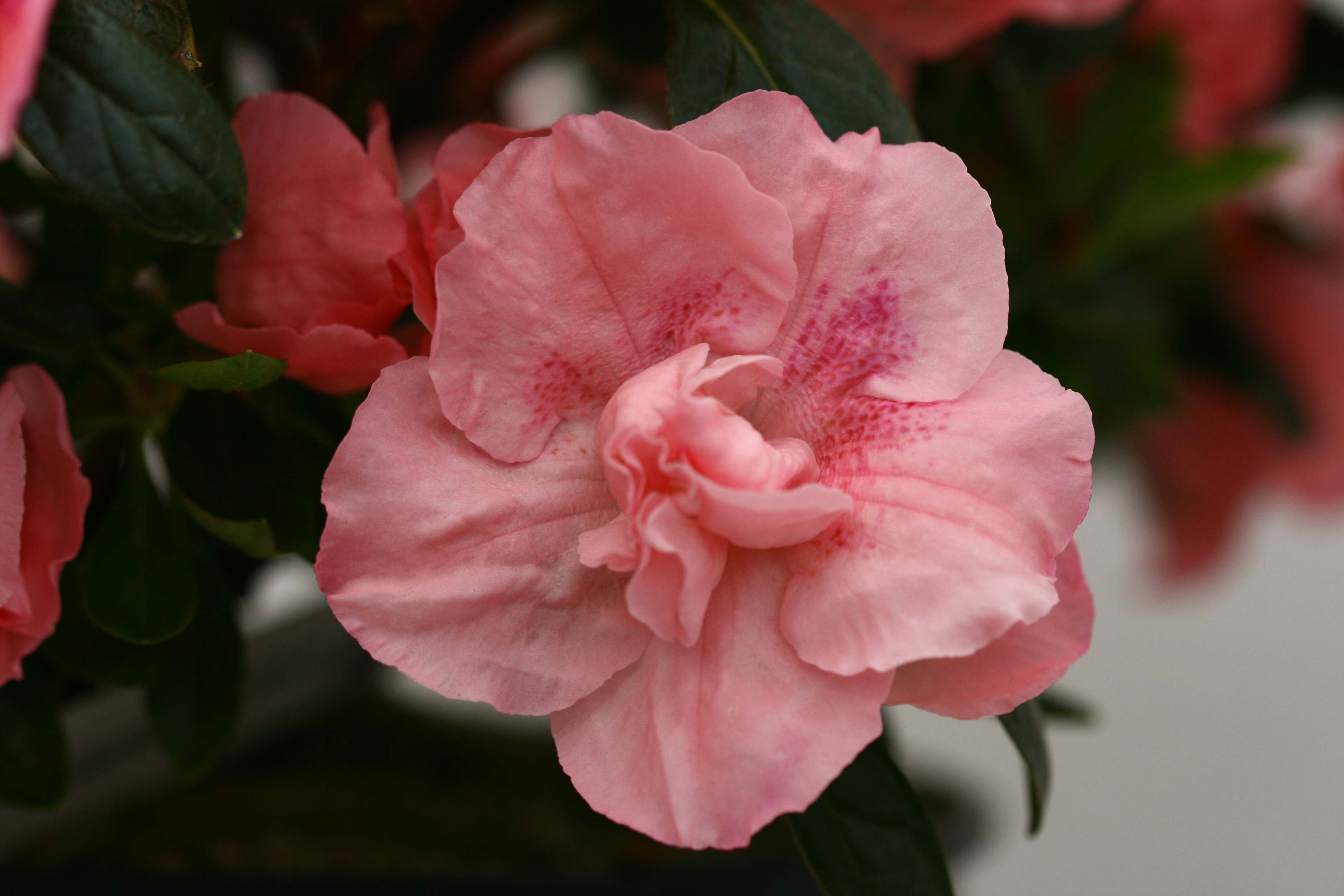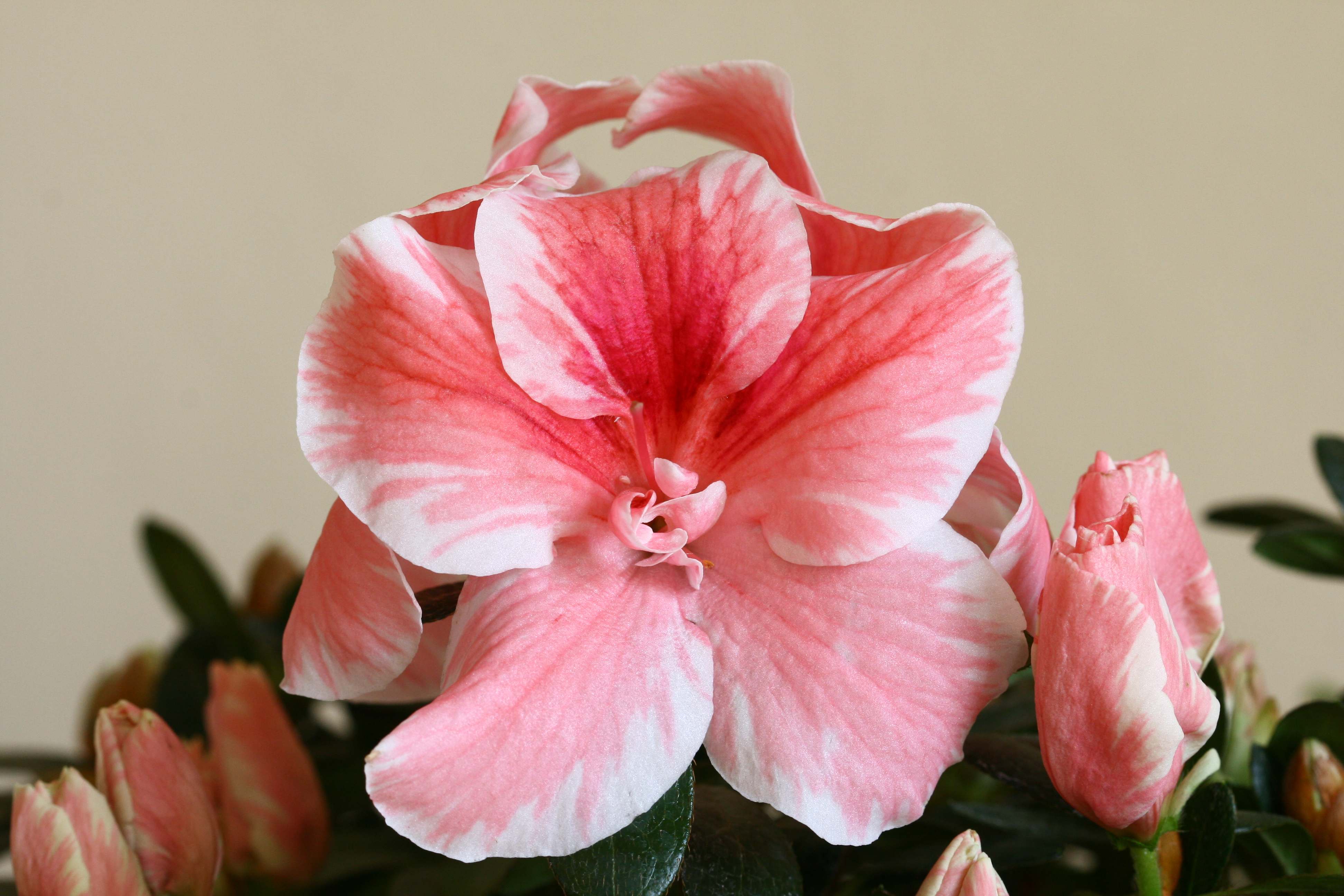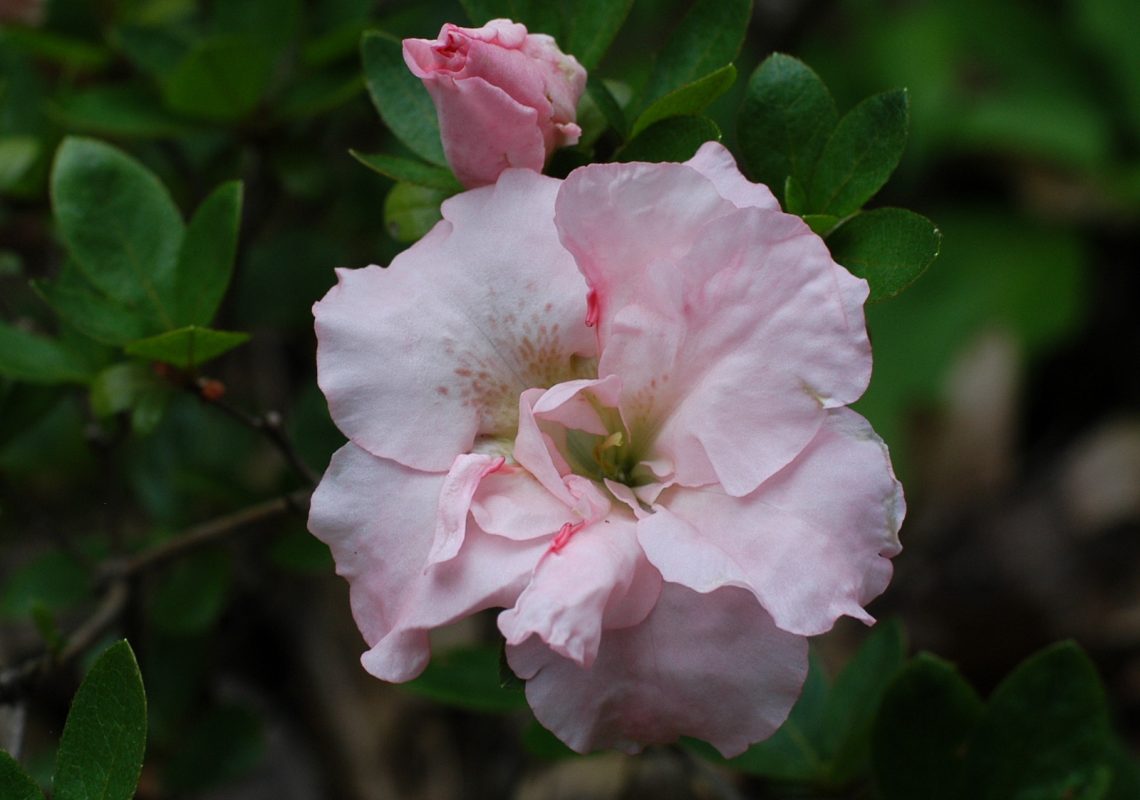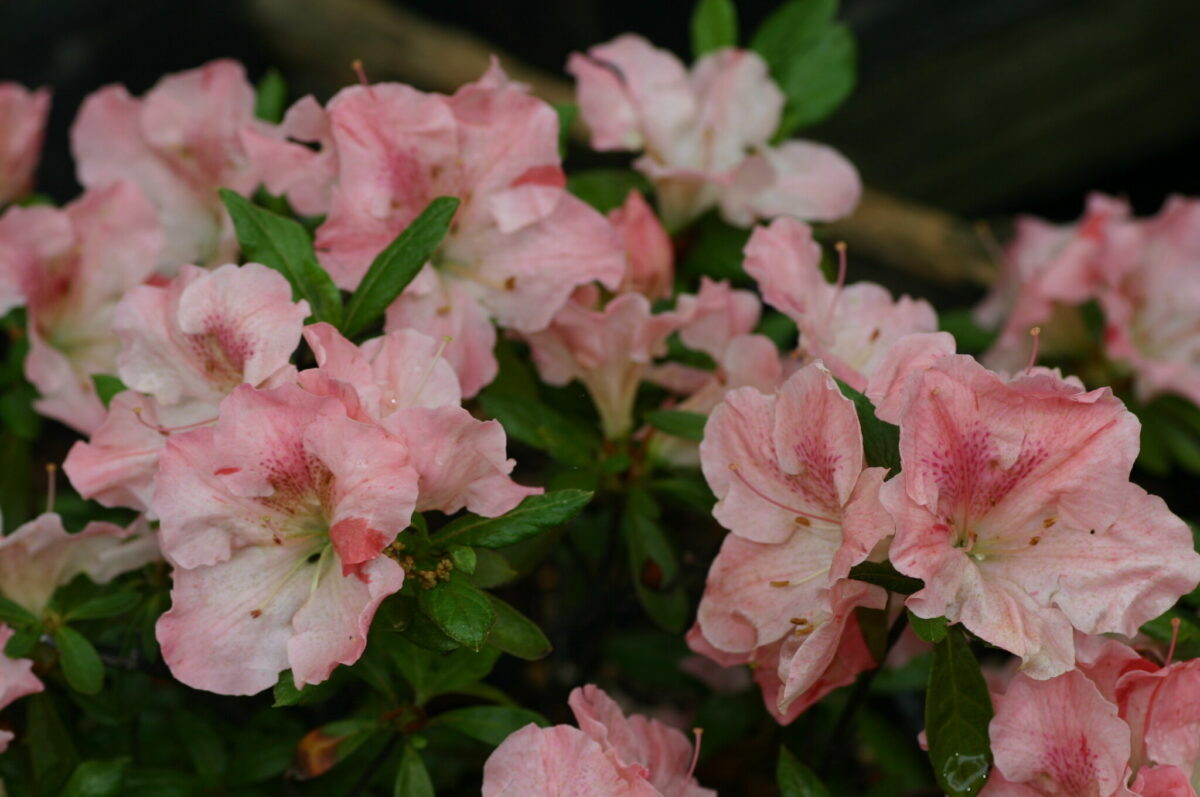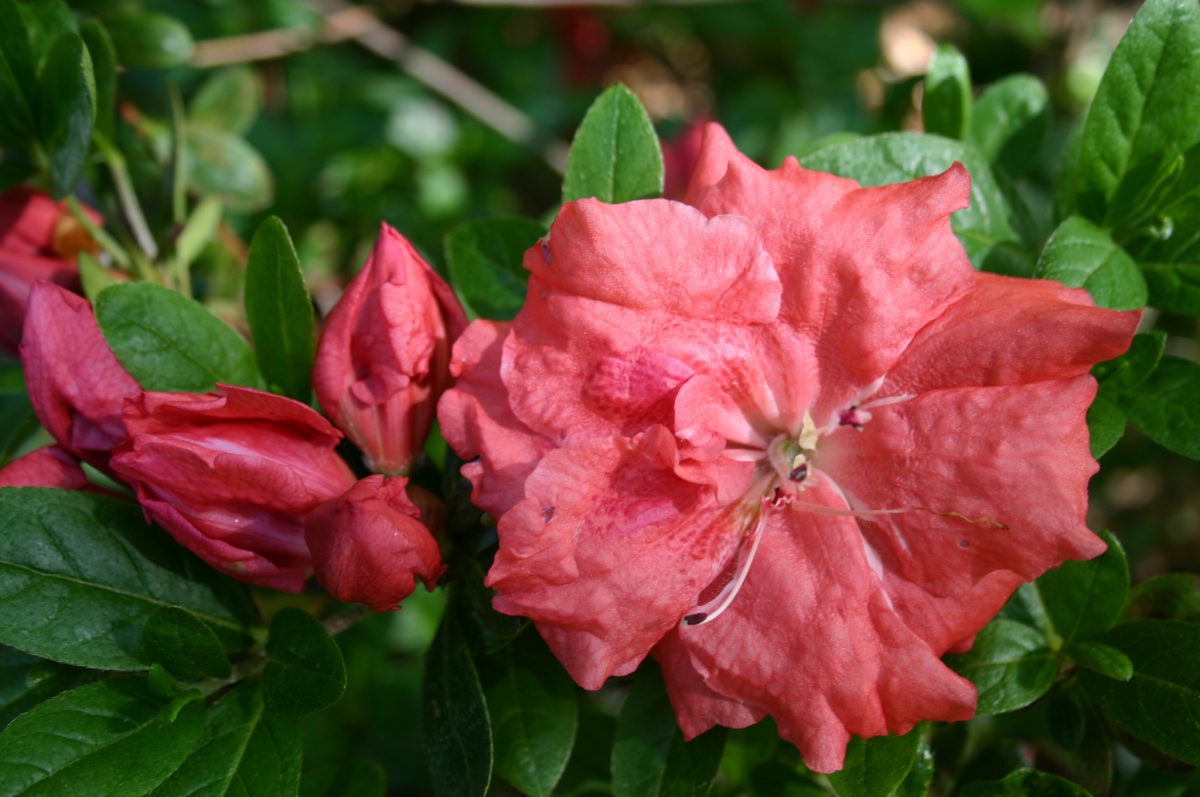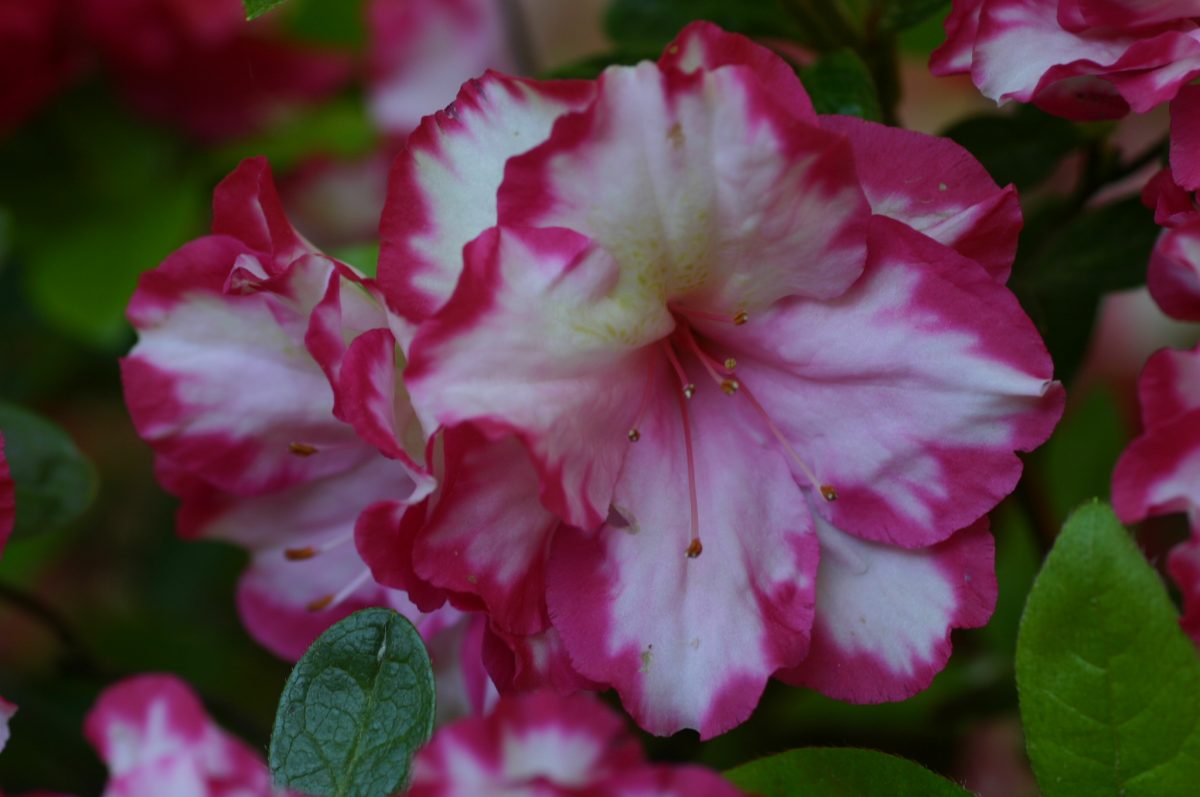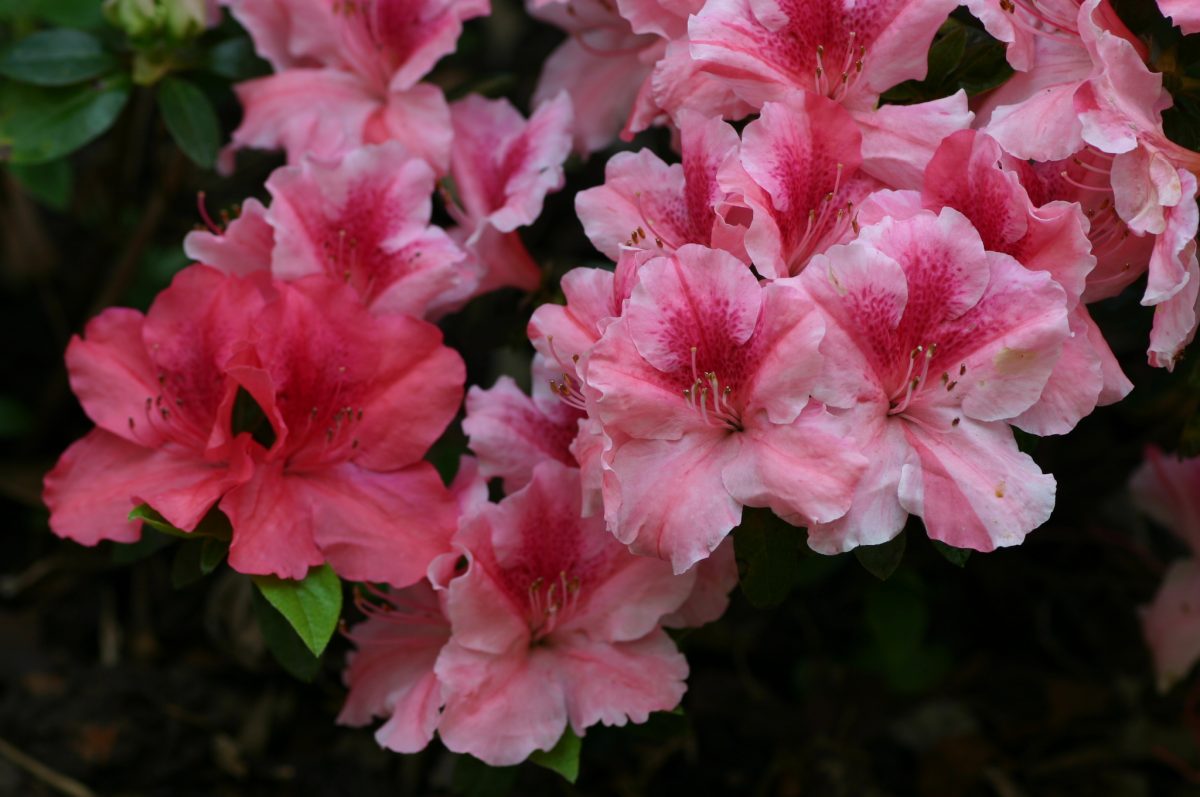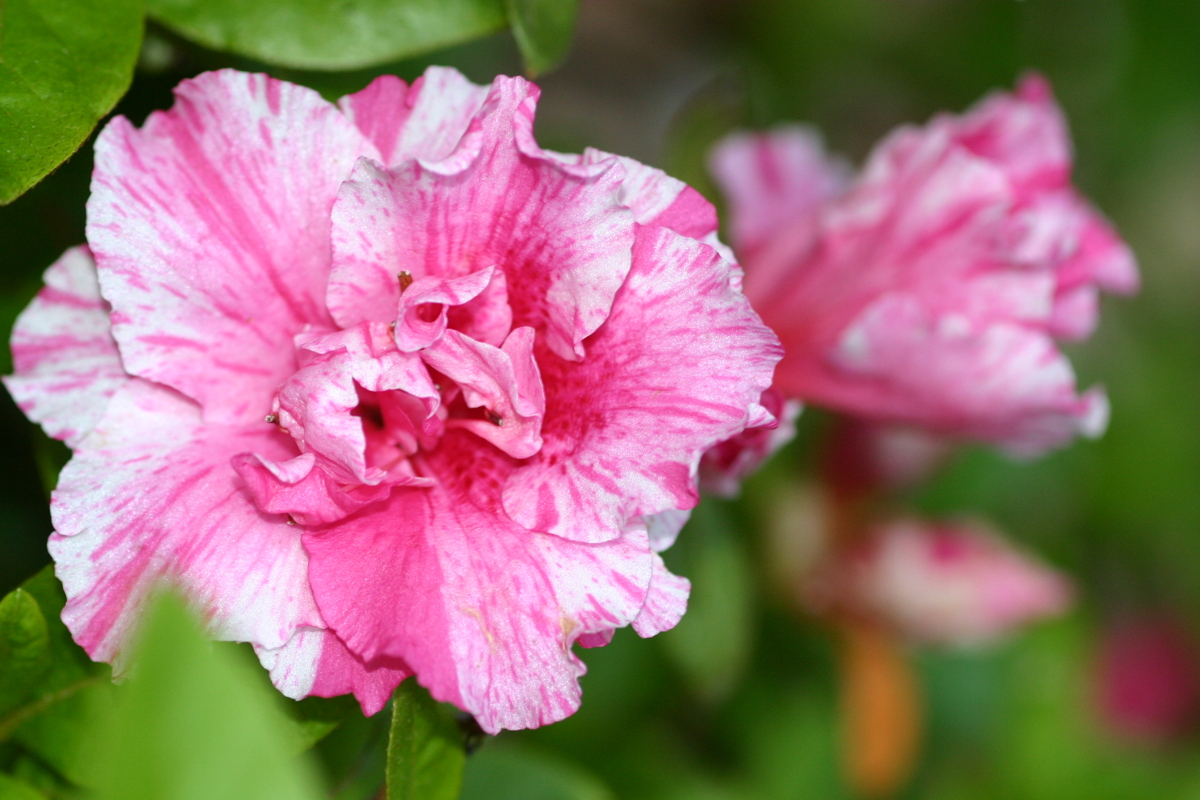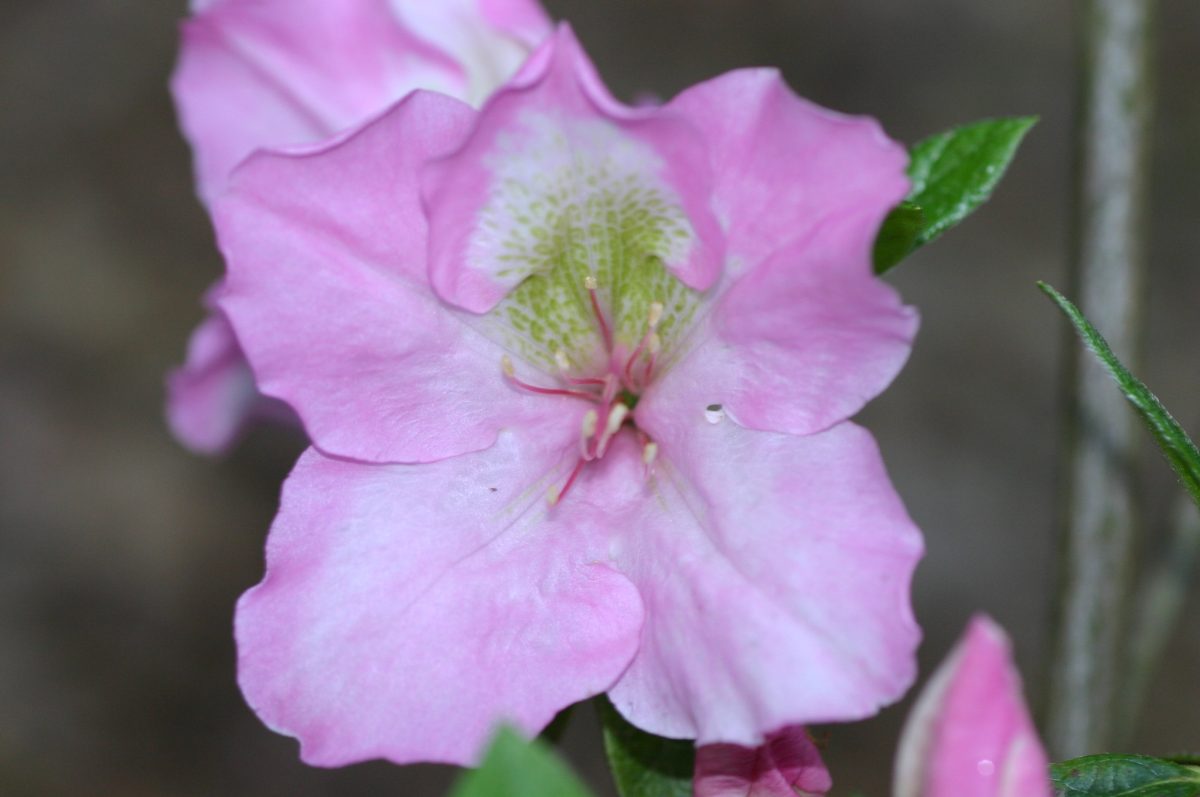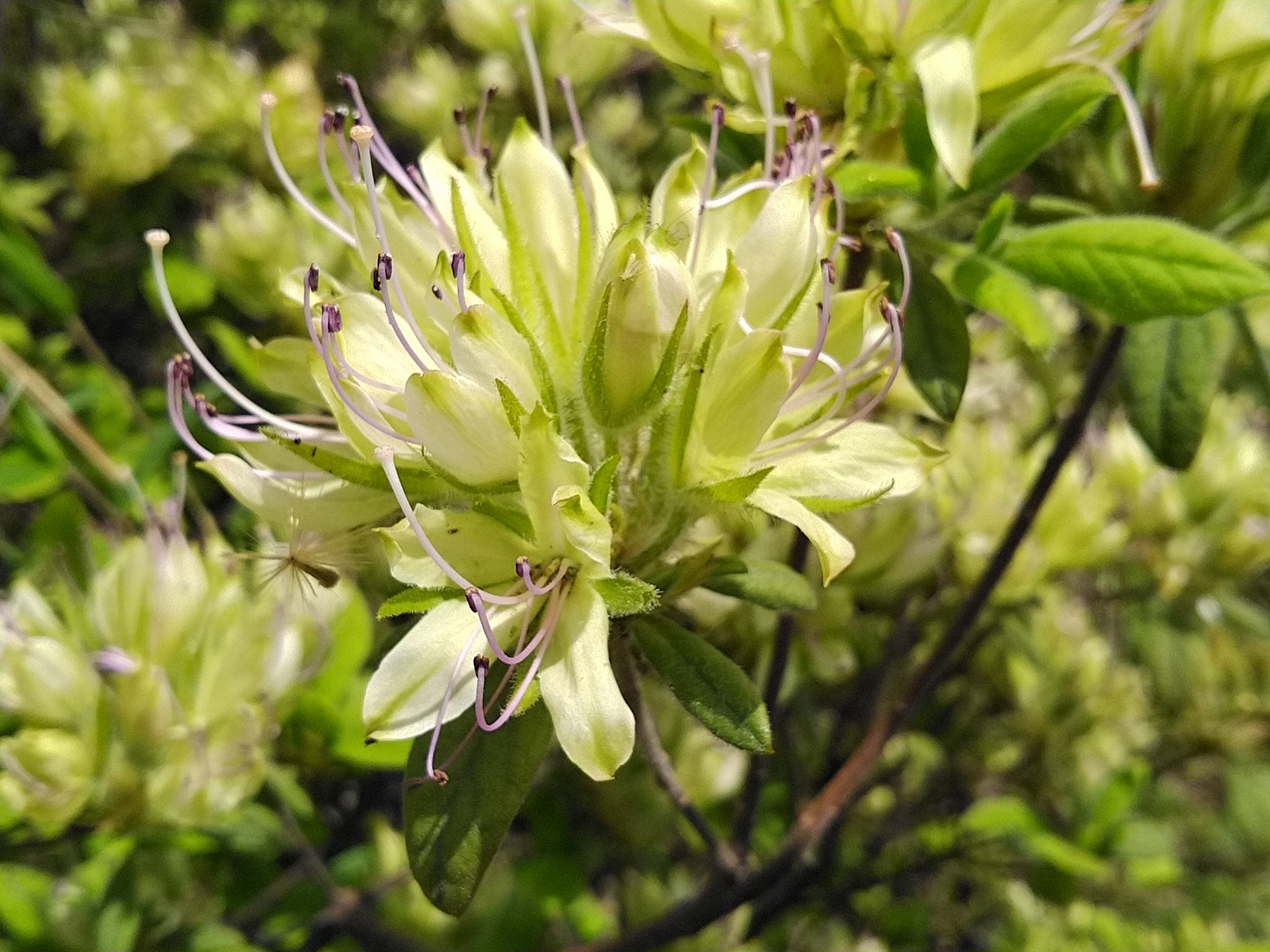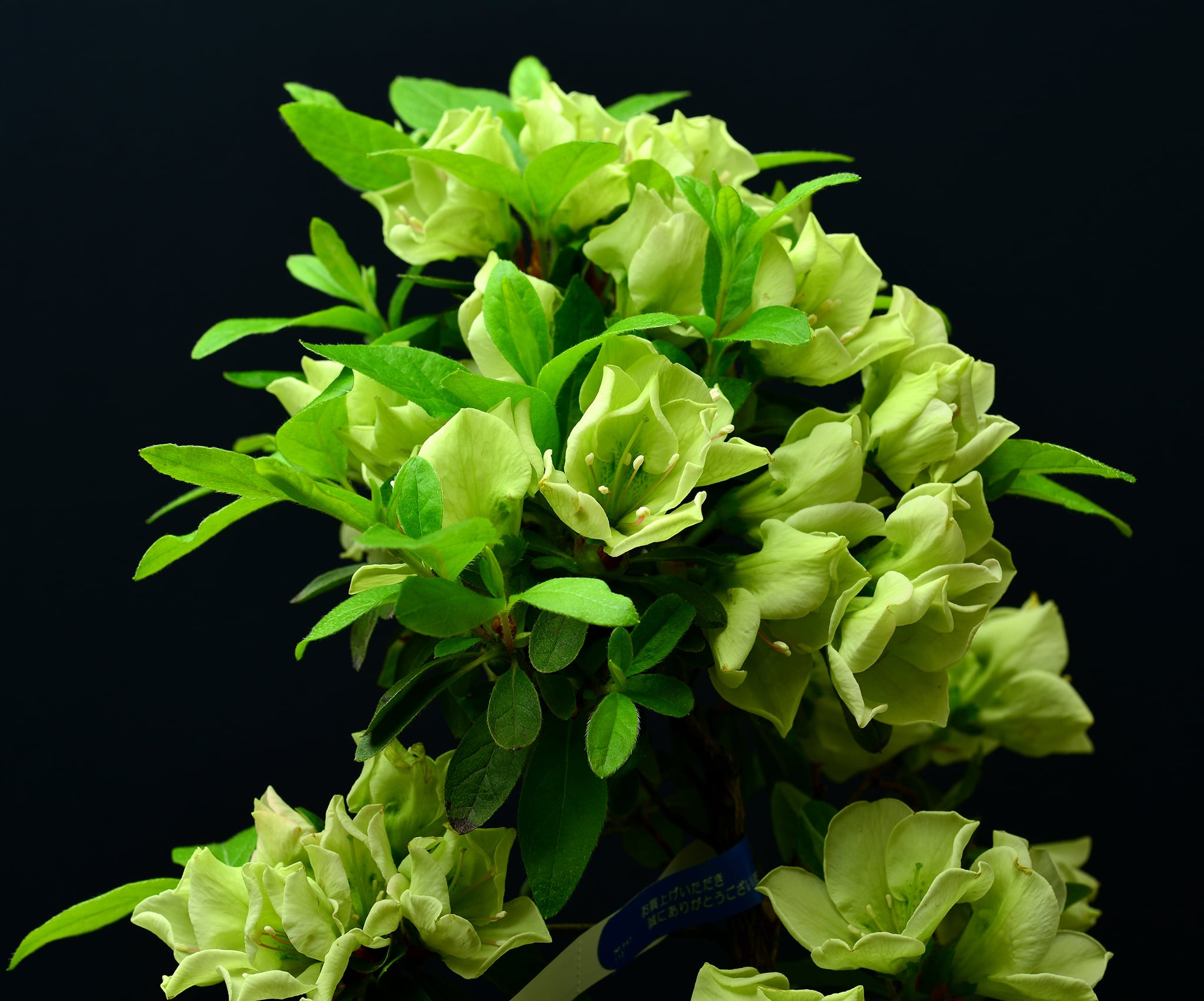
The history of azalea breeding in Europe and its influence on contemporary American hybrid varieties
How a Belgian variety from the 1890s named ‘Vervaeneanum’ connects the old with the new
In this article, I will take the reader on a journey from the earliest descriptions of evergreen azalea cultivars to the beginnings of azalea breeding in England and Belgium.
Making a jump across the Atlantic, this article will allow the reader to place some of their familiar azalea varieties into their historical context.
Next, I will show how American azalea hybridizers used these genetic resources to create contemporary azaleas, some of which have appeared as newly registered cultivars in The Azalean as recently as the 2024 spring edition.
Finally, we will return to Japan where Japanese breeders have built on the work of both their European and American colleagues to create their own new varieties.
Thanks to drawings from old horticultural journals as well as photos provided by Azalea Society of America members, I was able to create a visually impressive voyage.
In conclusion, I make a case for global interchange of varieties and reflect on the role of amateur hybridizers and propagators for both preserving and enhancing the richness of varieties.
The earliest historical accounts of evergreen azaleas are in the 17th century
The earliest mentions of evergreen azaleas are found in Japanese poetry. Manyoshu (万葉集) is a collection of Waka poetry dated to 759, containing several poems that mention azaleas specifically, as well as many Japanese plants.
The first horticultural mentions of azaleas in Japanese are found in Ikebana Denki (生花伝書, 1632), Kadan Tsuname (花壇綱目, 1681) and Kinshu-makura (錦繡枕, 1692).1
Kinshu-makura was authored by Ito Ihei (伊藤伊兵衛) and was translated to English by Kaname Kato and appeared under the name A Brocade Pillow and already lists 161 varieties.2
This indicates that azaleas were prized and cultivated for many centuries, before we got the first detailed accounts.
The Tokugawa government restricted trade with the outside world from 1603 to 1868, allowing only some Dutch and Chinese traders to visit Japanese harbors.3
For this reason, many azalea varieties were introduced to Europe either through China or Indonesia, as Indonesia at that time was known as 'Dutch India'.
This explains why the earliest evergreen azaleas were named Azalea indica or "the Chinese azalea".
Donald H. Voss wrote an excellent article on this aspect of azalea history in The Azalean of 2000, Fall Edition.4
Japanese nurserymen and horticulturalists also lacked the western understanding of plant breeding, like deliberate crossbreeding.
This knowledge was introduced to Japan only after the Meji Restoration (1889) and taught to azalea growers by Toshio Tanigawa in 1910.5
The first evergreen azalea to arrive in Europe is ‘Breynii’ in 1680.
This plant was described by Jacob Breyne, a Polish merchant and naturalist, in his Prodomi in 1739.6
He observed this plant on the estate of Hieronymus van Beverningh near Leiden, the Netherlands.
The description is brief and does not include a drawing, but it does include this comment: "This is one of the rarest and most elegant things that we have ever seen".
Engelbert Kaempfer described an evergreen azalea in his Amoenitates Exoticae from 1712 while Carl Linnaeus gave the azalea its name Azalea indica in his work titled Genera Plantarum published in 1737.
However, it should be noted that physical specimen of evergreen azaleas would have been extremely rare in Europe at that time.
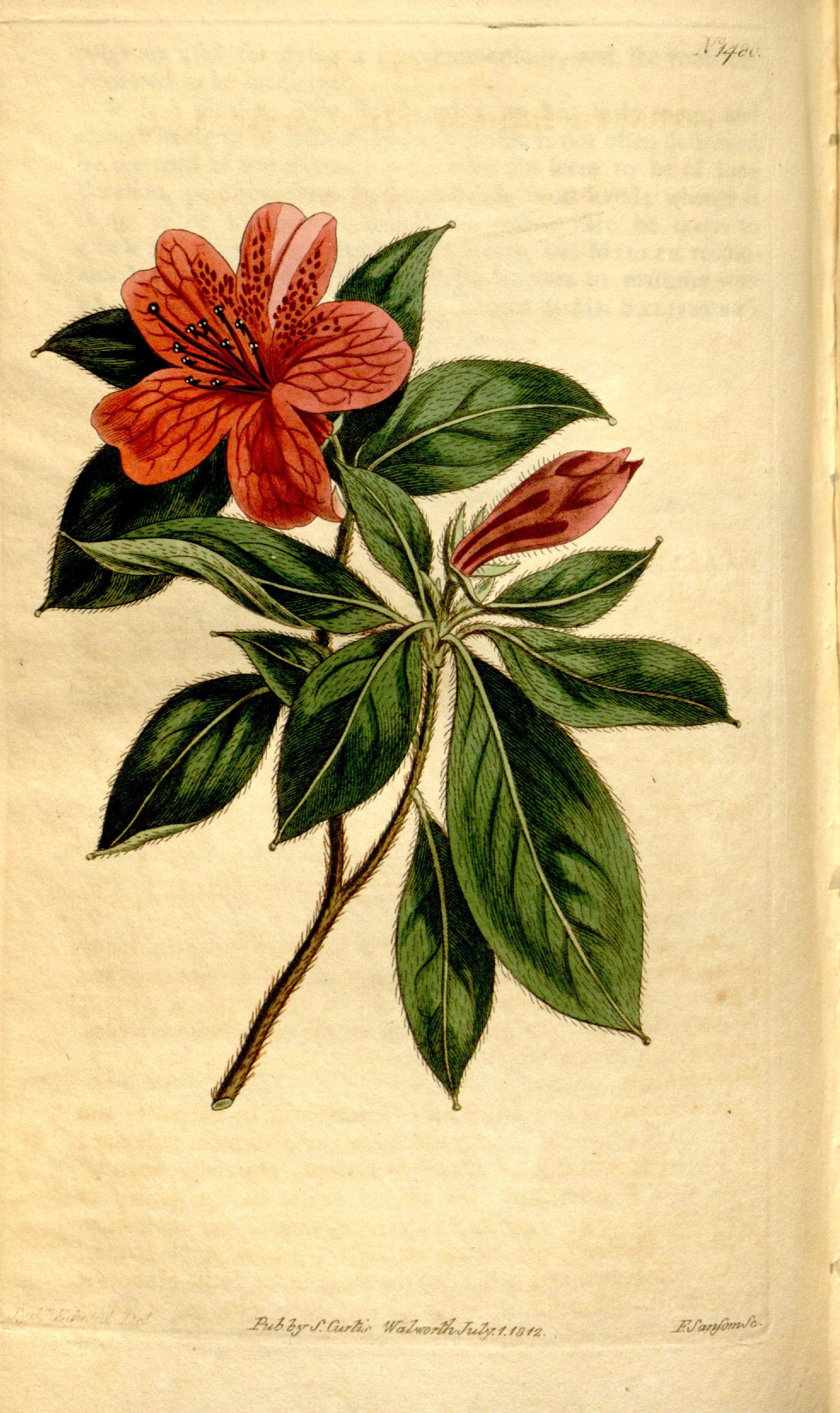
Figure 1. The original ‘Azalea indica’, introduced from China to England in 1812. This is very likely to be a selection of R. simsii
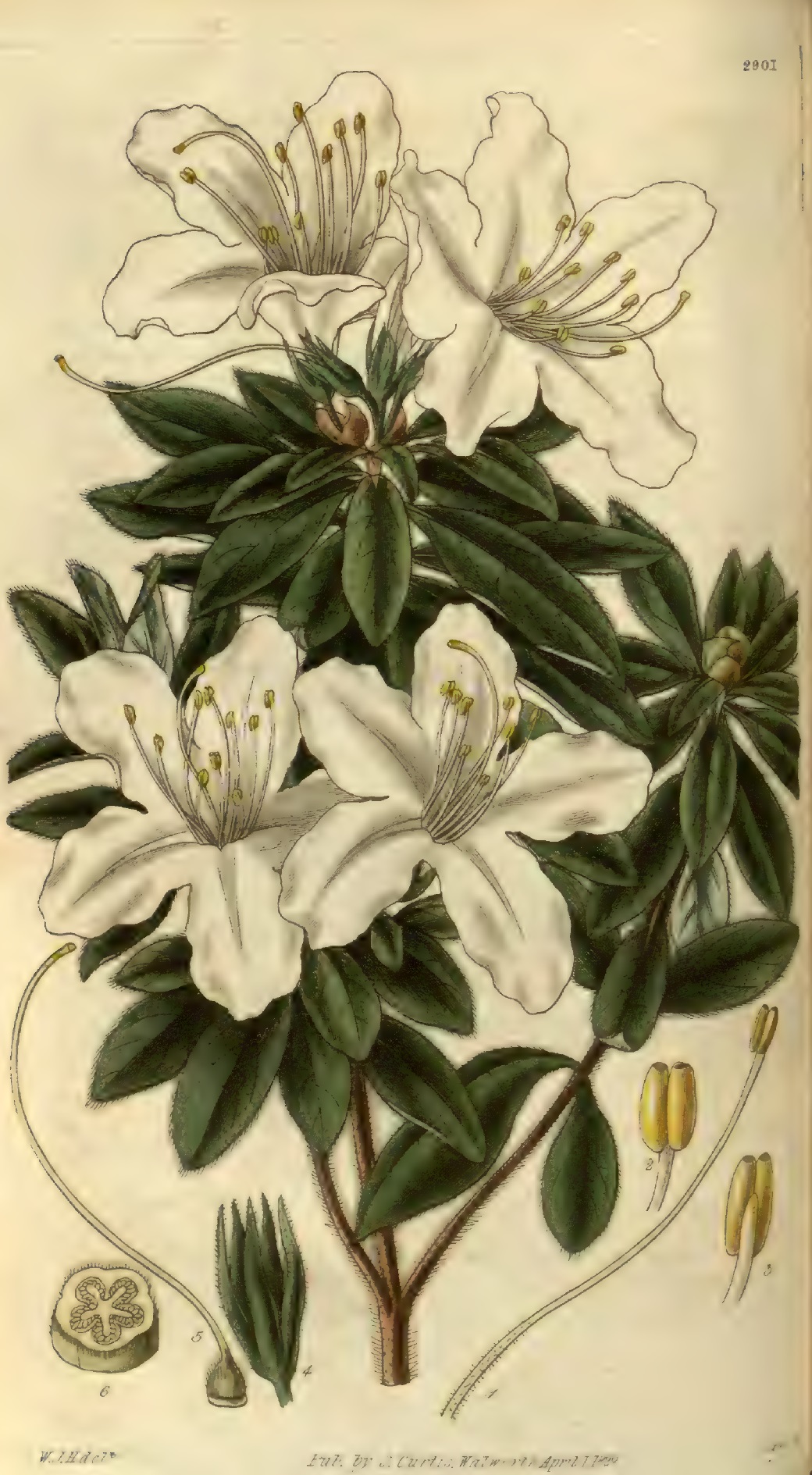
Figure 2. ‘Ledifolium’, introduced from China to England in 1819, almost certainly a form of R. mucronatum.
The introduction and documentation of the first two azalea varieties in England in the early 19th century
In the early 1800s, a culture of collecting exotic plants developed across western Europe.
Greenhouses, exhibitions, and botanical journals played a key role. Initially, this was mostly a hobby of those in the upper class, but the industrial revolution was slowly creating a middle class.
At this point in history, both enthusiasts and professionals already had a good understanding of the concepts of wild species, cultivars, and hybrid crossbreeding, as well as the distinction between evergreen azaleas, deciduous azaleas, and rhododendrons.
All evergreen azaleas were recognized as Azalea indica and these were kept in greenhouses for winter protection.
Only later it was discovered that some evergreen azaleas were winter-hardy in western Europe, leading to the alternative term Azalea japonica.
Proper botanical names for wild species arose at a later point, which resulted in the famous confusion between Azalea indica and Rhododendron indicum.
The first evergreen azalea pictured in a journal was titled ‘Azalea indica’ in Curtis Botanical Magazine in 1812 (figure 1).7
This almost certainly depicts some form of Rhododendron simsii.
I say this because of the ten stamens, the small red flower relative to the larger leaves, and the blotch being a darker shade of red.
This original ‘Azalea indica’ is described as a hardy plant, but its major flaw was the poor arrangement of flowers and its loose, branchy plant habit.8
This trait seems to confirm a wild-type origin for this selection, rather than a garden hybrid with improved horticultural qualities.
The key characteristic of ‘Azalea indica’ is that it blooms early, a trait that would go on to play a key role in obtaining varieties suitable for greenhouse forcing.
The second azalea introduced in 1819 was Azalea ledifolium or ‘Ledifolium’ (figure 2), which matches the description of what we today call R. mucronatum.9
This azalea offered large flowers, strong blotches, purple colors, and scented flowers. This plant is also known as Azalea album, and similar forms were later named ‘Noordtianum’.
The satsuki azalea arrives in England
Two more new azaleas appeared in Edwards Botanical Register of 1834, ‘Lateratium’ (figure 3) and ‘Variagatum’ (figure 4).10
The author makes it clear that the leaves and plant habit on both plants are identical, but their flower colours being different.
Both plants are highly likely to be Rhododendron indicum or some satsuki hybrids dominated by it.
These azaleas have five stamens and are described as more compact and low-growing than the other Azalea indica.
Wilson mentions that ‘Variegatum’ is known as ‘Matsushima’ in Japan, which is a very old and famous satsuki cultivar.11
Another form of R.indicum was introduced as Azalea Danielsiana, which most likely is the same plant as ‘Macranthum’ and might be the Japanese cultivar today known as 'Osakazuki'.
These varieties were described as very low growing, bushy plants, but less woody and hardy than other Azalea indica.
The flowers of these varieties, and their direct offspring, were considered superior due to their delicate bicolors and symmetrically shaped flowers.
For the first few decades, the goal of many European azalea breeders was to obtain varieties with the beautiful blooms of ‘Variegatum’, but with a hardier habit and faster growth rate of other Azalea indica varieties.
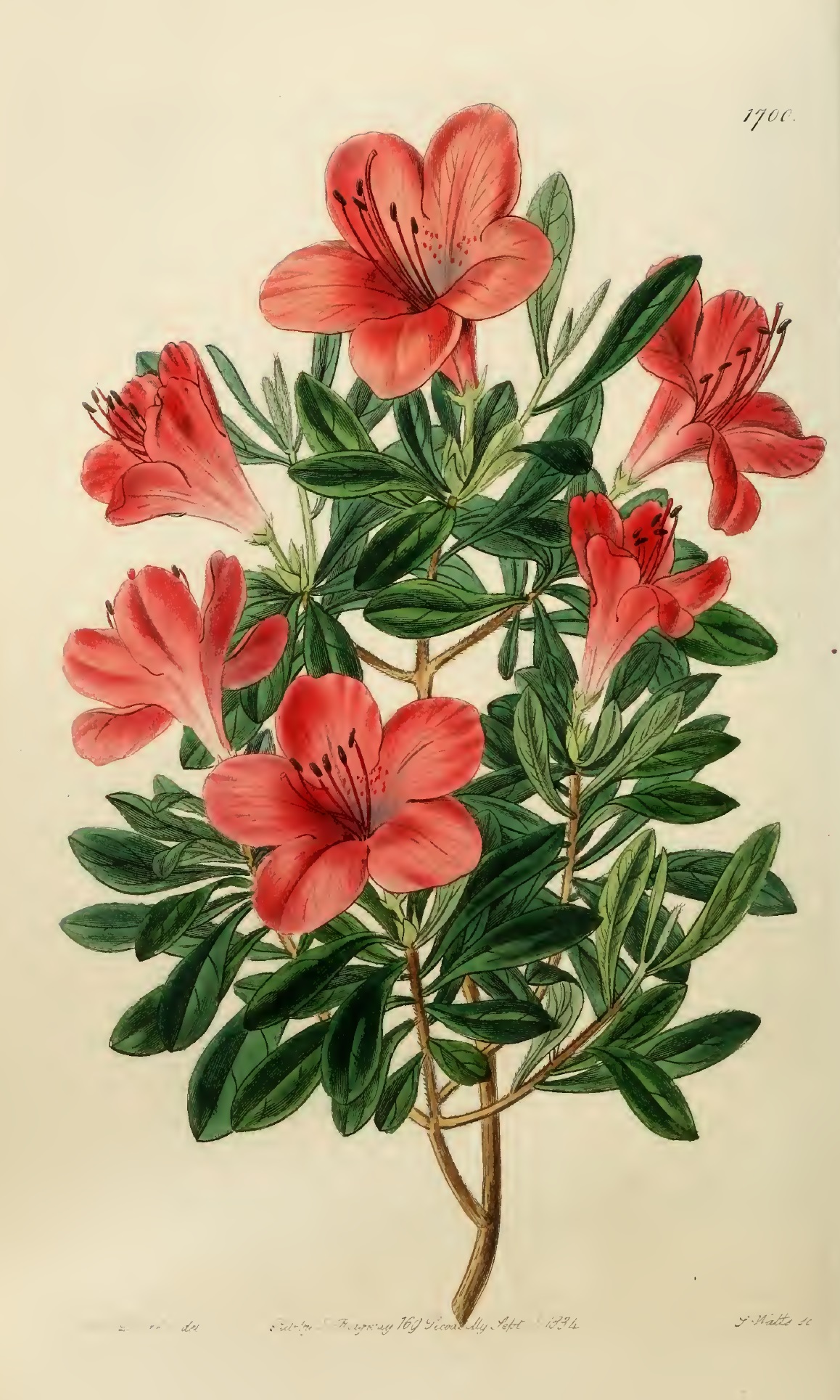
Figure 3. ‘Lateratium’, introduced from China to England in 1834. This is very likely to be a selection of R.indicum
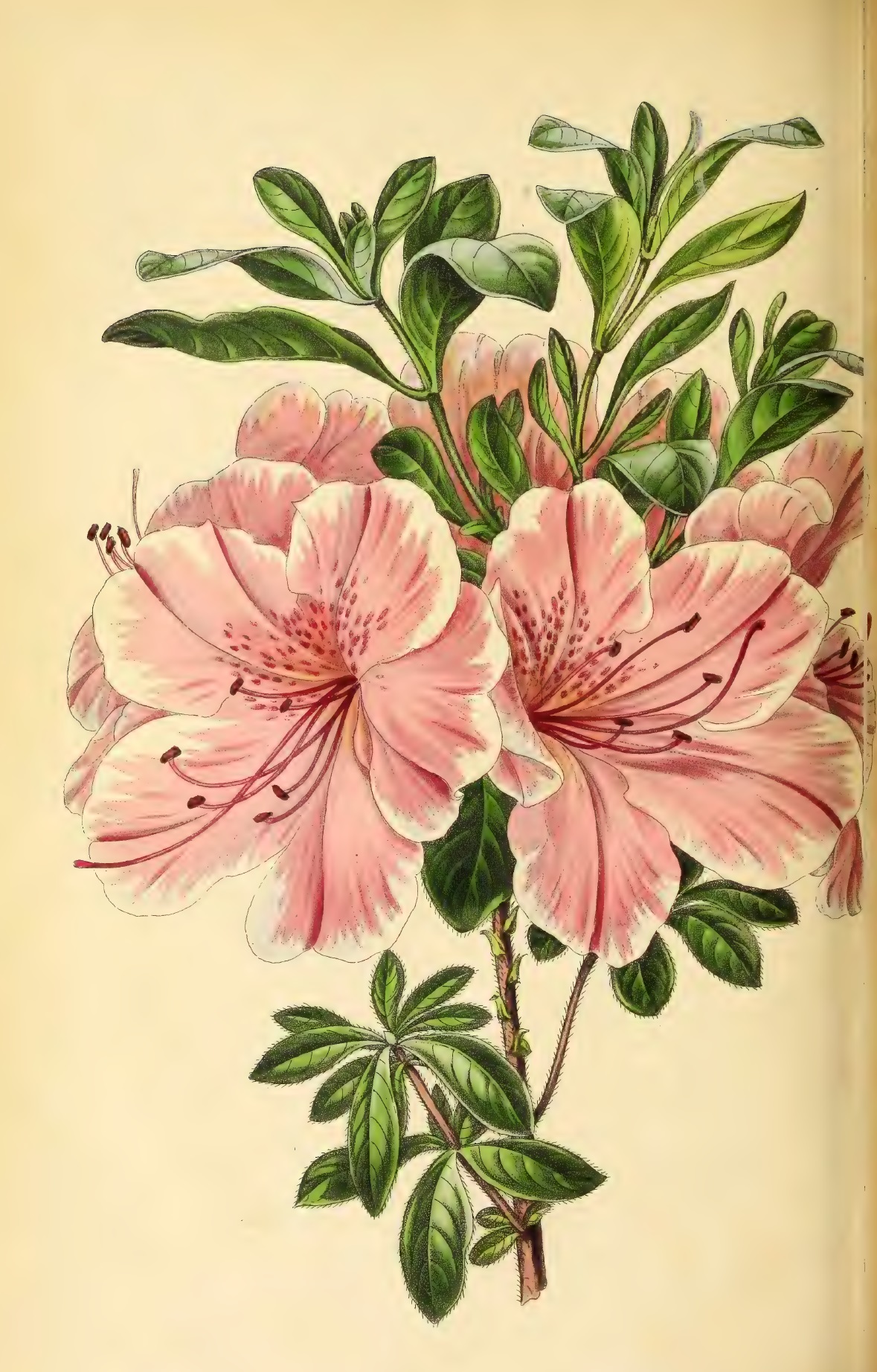
Figure 4. ‘Variegatum’, introduced from China to England in 1834, possibly the Japanese satsuki ‘Matsushima’.
‘Président Claeys’ is a sport of ‘Variegatum’, named by Eduard van der Cruyssen in Belgium in 1858.
In the US, this plant's name was changed to ‘President Clay’ (figure 5).
Some places in the US as of today still sell an azalea named ‘President Clay’. However, it is not clear if in present day United States, this is still the same plant as the original.
Many very old cultivars were eventually mislabeled or misnamed.
The true ‘President Clay’ should exhibit the jewel-border pattern, with five stamens, and a plant habit similar to R.indicum.
Azaleas with bicolour patterns will eventually produce solid-coloured sports.
So without proper propagation procedures and checks, it is likely that the ‘President Clay’-label has been applied to solid pink sports of the original plants.
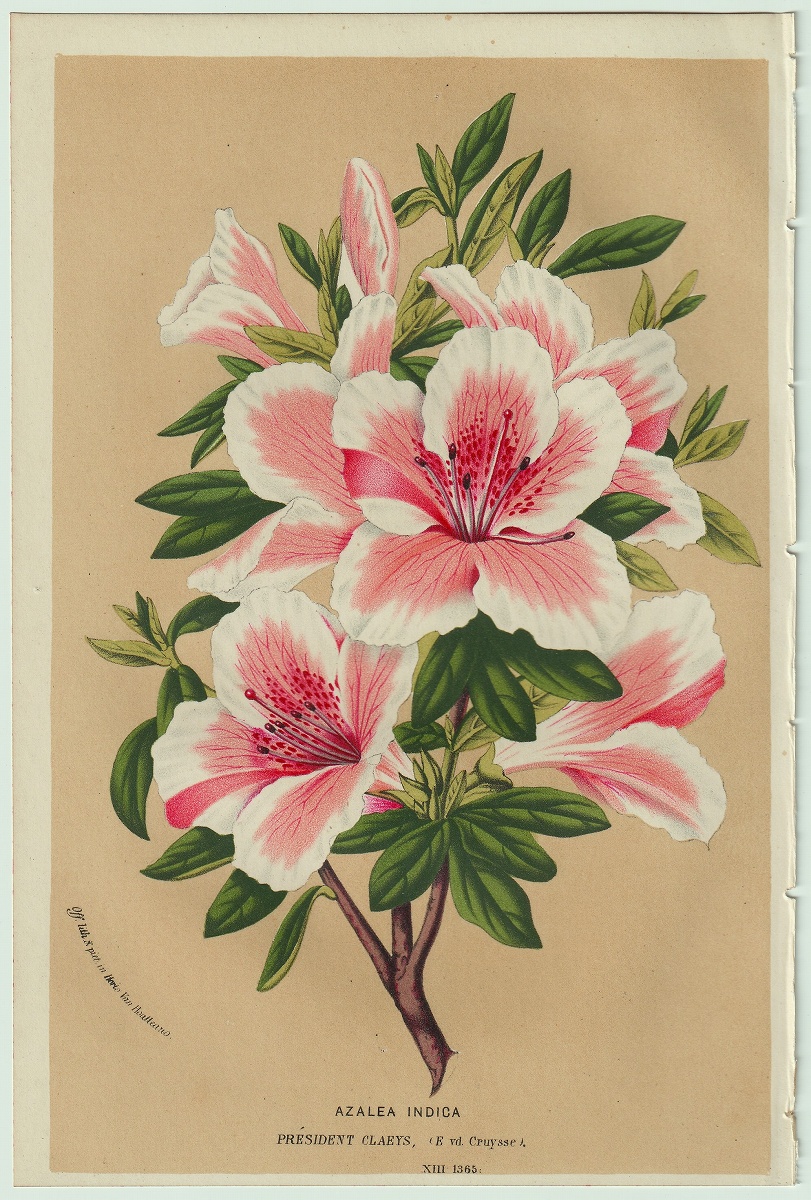
Figure 5. ‘Président Claeys’, a sport of ‘Variegatum’, one of the satsuki ancestors of Belgian indica azaleas
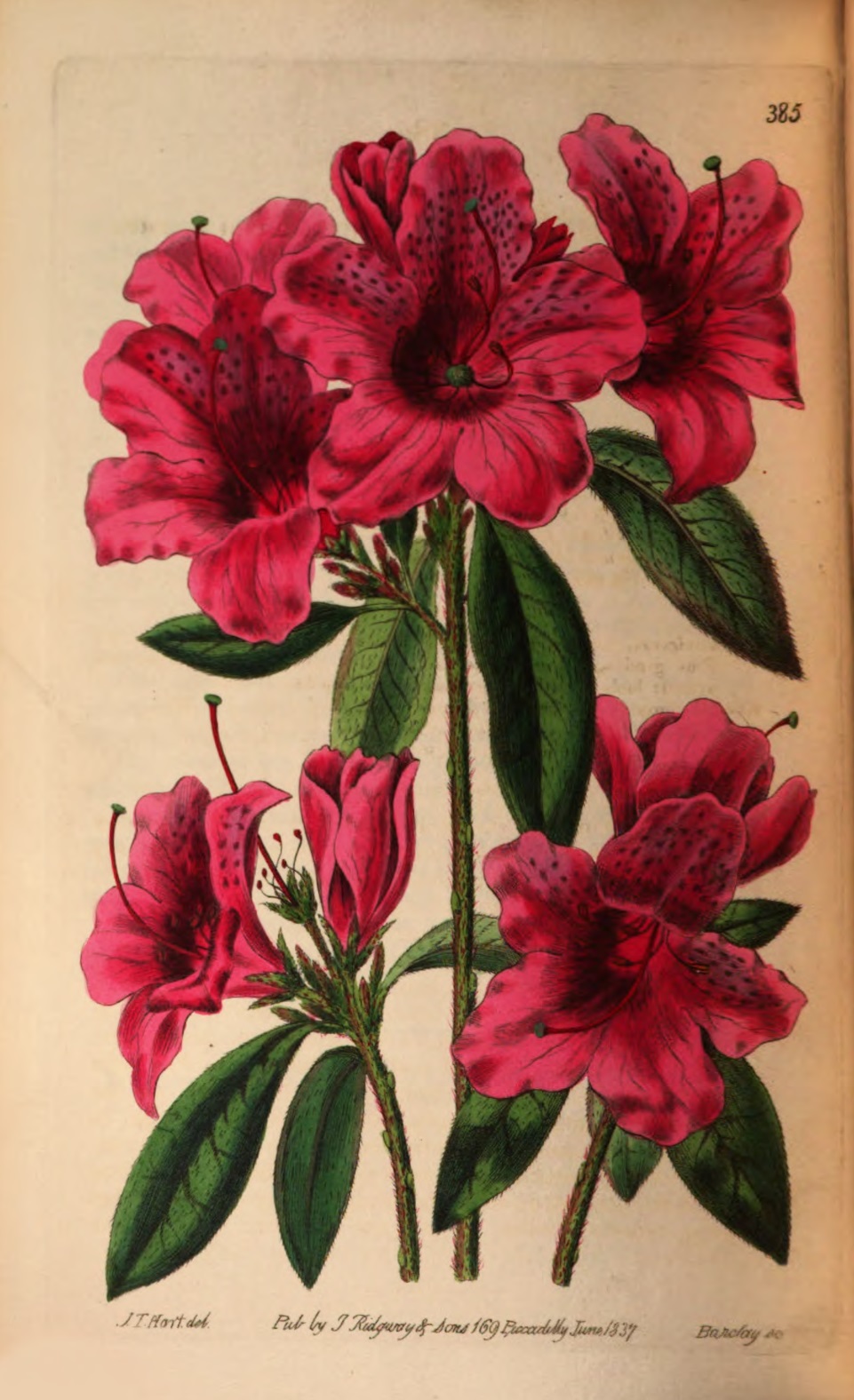
Figure 6. ‘Phoeniceum’, a Hirado azalea that is very closely related to ‘Omurasaki’.
The Hirado azalea is the final piece of the puzzle to arrive in Europe
A final very important azalea pictured in these journals is ‘Azalea phoeniceum’ (figure 6).12
This azalea seems very similar to, or perhaps identical with, ‘Omurasaki’ (大紫 or オオムラサキ), the Hirado (平戸) azalea (or more precisely Okirishima azaleas / オオキリシマ) from Southern Japan.
Hirado azaleas come from the city of the same name, located north of Nagasaki. Because of the mild climate, the estates of prominent samurai included large plantings of various types of azaleas.
These naturally hybridized, over time producing a series of named cultivars.1
Therefore, ‘Phoeniceum’ is a R. pulchrum azalea, which are believed to be hybrids of R. scabrum and either R. ripense or R. mucronatum.13
The Ryukyu azaleas (リュウキュウツツジ), which we also refer to as R. mucronatum, likely also from the same Hirado estates, though are named after the chain of islands south of Japan.
‘Phoeniceum’ is vigorous grower and was used as grafting stock for most Belgian indica azaleas for many decades, until it was replaced by ‘Coccinum’ (not to be confused with the species R. coccinum<.i>), ‘Hexe’ and later ‘Euratom’.
Today, Belgian indica varieties can be mass produced on their own roots.
The genetics of ‘Phoeniceum’ created stronger-growing plants, with large leaves, robust root growth, and large purple flowers.
In the US, sports of ‘Omurasaki’ are grown as the Southern Indian varieties ‘George L. Taber’ and ‘GG. Gerbing’.
English nurserymen start raising seedlings and naming new varieties in the 1840s and 1850s
Immediately after the introduction of these five plants from Asia, we get records of new seedlings being raised.
It seems that the horticultural community in Western Europe during the early 19th century was primed for new azaleas.
Skilled nurserymen, who had honed their craft on hybridizing tulips, carnations, and orchids, became smitten with the new azaleas and immediately began producing more varieties.14,15
The first new variety was raised in 1830 by William Smith from Coombe Wood, Kingston (today part of London), later employed as a nurseryman at Norbiton, and was named ‘Pulchrum’ (figure 7, not to be confused with R. pulchrum).
It is suspected to be a hybrid of ‘Ledifolium’ and R. simsii.
Clearly not the most impressive azalea in this article, based on its drawing, though a start of more to come.
The Florist, Fruitist, and Garden Miscellany journal from 1853 already lists 81 varieties of Azalea indica, including brief descriptions but lacking any drawings.16
Most of the initial seedlings seem to have been produced in England. William Smith was the most prolific of the early hybridizers and produced his new varieties in the 1830s.
Some of them are said to have been marketed by Knight and Perry.
The names of the most important new varieties by these three Englishmen include: ‘Apollo’, ‘Broughtonii’, ‘Exquisitum’, ‘Optimum’, ‘Punctatum’, ‘Smithii’ and ‘Speciosum’.
It should be noted J. Knight's ‘Apollo’ from 1843 is not the same as the one by Carl Schulz from 1878, and that Smith's ‘Punctatum’ from 1845 is not the same as Robert Fortune's ‘Vittata Punctatum’ from 1850.
The number of Azalea indica varieties that were registered was enough to result in duplicate names and the associated confusion.
Many early English varieties later became well-known as Southern Indian azaleas
Another notable variety from England during this time is ‘Glendstanesii’, introduced by W. Rollisson & Sons.
‘Pride of Dorking’, ‘Danielsianum’, and ‘Cavendishii’are three other important azaleas introduced in England during this period, though their hybridizers are unknown.
Finally, there is ‘Fielder's White’ by Fielder.
In 1850, Robert Fortune introduced several more azaleas from China: ‘Vittatum’, ‘Vittatum Punctatum’, ‘Bealei’, ‘Narcissiflorum’ and ‘Crispiflorum’.
While the plant ‘Vittatum’ has been much discussed17 and often referred to as a Chinese azalea, or a form of R. simsii, this seems unlikely to me.
I propose that it is actually a form of R.mucronatum called ‘Ryukyu Shibori’ (リュウキュウ絞り / 琉球絞り), though it seems likely that several different forms of variegated R.mucronatum azaleas have carried this name.
Some of Fortune's introductions were put on the market by in England by Standish & Noble.
Another early hybridizer of azaleas in England was J.Ivery. He obtained two azaleas that he named ‘Iveryanum’ and ‘Formosum’.
‘Iveryanum’ has an unknown parentage, but it is most likely a seedling of ‘Variegatum’.
‘Formosum’, also known as ‘Formosum’, ‘Lateritium Formosum’ or ‘Conquerer’, is describted to be similar to the original ‘Lateratium’ and therefore likely a satsuki-like hybrid.
In Belgium around 1860, a sport of ‘Formosum’ was named ‘Dieudonné Spae’ (figure 8) and displayed in L'Illustration Horticole 1860.18
The drawing displays a flower with a jewel-bordered bicolor pattern and five stamens, confirming its satsuki heritage.
Two other azaleas were named ‘Formosum’. One by Knight & Perry in 1839 and one by Carl Schultz in 1885.
Several contemporary American azaleas under the names ‘Formosa’ ‘Red Formosa’ and ‘Purple Formosa’ do not resemble the drawing of ‘Dieudonné Spae’.
Likely, these American azaleas are ‘Phoeniceum’ or R. pulchrum hybrids.
It seems most likely that these American azaleas are sports of Schultz ‘Formosum Grandiflora’ which is described as a large cherry-red flower.20
In the US, this ‘Formosa’ has produced a sport named ‘Judge Solomon’.
Many azalea varieties were given different names or gained synonyms at some later point.
‘Cavendishii’ is also known as ‘Lady Cavendish’.
‘Smithii’ is probably also known under ‘Smithii Coccinea’, ‘Concinnum’, and ‘Rawsonii’.
These varieties help us trace the origins of many Southern Indian azaleas found in the Deep South of the United States.
Some of these, like ‘Iveryanum’ and ‘Pride of Dorking’, are still available in the nursery trade today.
And in Europe, all these varieties set the stage for the development of the florist azalea, or Belgian indica azalea.
It seems that from the 1850s onward, very little new varieties were introduced from Asia. And that the varieties named above formed the genetic base for a 150-year long breeding project.
The ancestery of some early varieties can be linked back to the original Asian introductions
Many hybridizers of Azalea indica did not record the parentage of their new varieties. This makes it very challenging and often impossible to trace the origins of today's azaleas back to the forementioned.
However, there are a few exceptions.
For ‘Speciosum’, we know R.indicum was pollinated with pollen from ‘Phoeniceum’, as stated in the description accompanying the drawing in British Flower Garden series 2 Vol3. of 1835.
Likely, the author here referred to ‘Lateritium’ or ‘Macranthum’, and not to ‘Azalea indica’.
‘Exquisitum’ (figure 9) was used as a seed parent by J. Ivery, with ‘Iveryanum’ as the pollen parent.
A seedling Mr. Ivery then obtained was named ‘Criterion’.
Furthermore, he used ‘Iveryanum’ as the seed parent with ‘Formosum’ as the pollen parent to obtain ‘Admiration’.
A drawing from the Florist, Fruitist & Garden Miscellany of 1852 shows ‘Admiration’ to be a white flower with pink variegation, while ‘Criterion’ is a jewel bordered bicolour (figures 10).19
In the 1840s and 1850s, many of these English varieties made their way to continental Europe, where plant breeders immediately generated a burst of new varieties.
Unfortunately, for almost all of them, we do not have any documented parentage.
One of the earliest Belgian varieties for which a parentage is known, is ‘Versicolor’ (figure 11).
Mr. Van Geersdale obtained this new variety in 1839 by crossbreeding ‘Speciosum’ with pollen from ‘Variegatum’.
Some of the other notable varieties produced early on in Belgium include ‘Alexandre II’ (figure 12), ‘Glorie de Belgique’, and ‘Comte de Hainaut’.
Unfortunately, these azaleas have no known parents or documented offspring.
It seems likely some of them are related to Ivery's varieties.
Additionally, ‘Vittatum’ and its sports are said to have been very popular in Belgium during that time, and to have been extensively used as a parent.
However, there is no record of any Belgian Azalea indica where ‘Vittatum’ is actually listed as a parent, making it not improbably that this azalea was a parent for at least some of the single-flower bicolour azaleas with more than five stamens.
The oldest known ancestors of the contemporary Belgian azalea indica varieties date back to the 1850s and 1880s
If we take the contemporary Belgian and German Azalea indica with the most complete pedigrees, and trace them back to the last known ancestor, we find some of the most notable varieties.
These are ‘Duc de Nassau’, ‘Deutsche Perle’ (figure 13), ‘Frits Sander’, ‘Professeur Wolters’, and ‘Madame van der Cruyssen’.
These were some of the most popular varieties in the early 20th century, but we cannot link them back to earlier cultivars.
‘Duc de Nassau’ was obtained by the brothers Mardner in Germany in 1854 and is a keystone variety for present day florist azaleas. Its parentage is not known.
Dr. Scheerlinck wrote the following about ‘Duc de Nassau’ in his 1938 book: "Variety of the very first rank, very large single flowers with wavy petals. Strong growth.
This variety has contributed significantly to improving the azalea indica. This variety was produced on a large scale."20
In 1870, Louis van Houtte obtained a sport of ‘Duc de Nassau’ that he named ‘Alice’ (figure 14).
A drawing of ‘Alice’ appeared in L'Illustration Horticole, Vol. 23 of 1876.21
Some of these varieties have been preserved in the genetic archives of either the Belgian or German government institutions.
From these ancestor varieties, newer varieties like ‘Hexe’, ‘Paul Schäme’ and ‘Madame Petrick’ (figure 15) were obtained.
During the 1870s and 1880s, German breeders of azaleas became more succesfull than their Belgian counterparts.
Dr.ir.Heursel explains this by noting that the German breeders focused on producing plants that were more profitable rather than more beautiful or unique.22
These newer varieties were better suited for greenhouse forcing, allowing them to bloom earlier in the season.
This enabled azalea nurseries to produce plants that were in bloom during the Christmas holidays, making them commercially much more successful.
By the 1960s, with the introduction of ‘Hellmut Vogel’(figure 16), florist azaleas could now be forced to bloom as early as August.
Thanks to this extensive hybridization effort, florist azaleas can be sold about to bloom from August to May.
This is in contrast to the original Azalea indica, that only bloomed inside a greenhouse in early spring.
Another trait that was strongly selected against was the habit of shedding spring leaves during autumn, a strategy the plant uses to enhance its winter hardiness.
Many winter-hardy garden azaleas are partially deciduous. Naturally, this was considered to be an unfavorable trait for florist Azalea indica, and varieties with this trait were eventually eliminated.
As a result, many of the other traits of R. indicum and R. mucronatum were also lost.
Because of its commercial success, the Belgian azalea indica became a highly specialized product
Rather than fanning out in diversity, the solid-coloured, double flower that is a representation of a R. simsii x ‘Phoeniceum’ hybrid, became the dominant type of Belgian indica azalea.
Instead of diversifying, the solid-colored, double flowers, representative of R. simsii x ‘Phoeniceum’ hybrids, became the dominant type of Belgian Indica azalea.
Varieties that were poorly suited for greenhouse forcing were abandoned, even though the drawings of the earliest and most popular Azalea indica, clearly show a strong satsuki influence.
It's important to note that consumers typically bought these azaleas just as they were about to bloom—during the winter months
The Belgian Azalea indica can bloom indoors for up to eight weeks, allowing this azalea to directly compete with cut flowers, rather than with other garden or landscaping plants.
Once the azalea finished blooming, consumers would often discard it. Outdoors, these plants typically wouldn't survive.
Although selection requirements for breeding new varieties were very strict, criteria for long-term garden performance were clearly not a priority
Aside from some breeding efforts in Italy, around the Lake Maggiore area23, the Azalea indica never really gained popularity as an outdoor garden plant in warmer parts of Europe.
Today, the Ghent azalea is an officially recognized Regional Product by the European Union.
About 85% of all Indica azaleas produced in Europe, are produced in the Ghent area, with most greenhouse nurseries in the town of Lochristi, just Northeast of Ghent.
After years of decline, the market for Belgian indica azaleas now appears to have stabilized.
The notable variety ‘Vervaeneanum’ was a landmark and critical point in azalea breeding
Going back to the earlier days, one variety stands out— ‘Vervaeneanum’ (figures 17 and 19), obtained by Joseph Vervaene in Belgium in 1884.
The parentage is generally given as ‘Koningin der Weissen’ x ‘Versicolor’.
The story goes that an unnamed seedling from this crossbreeding gave rise to two sports: one was named ‘Vervaeneanum’, and the other ‘Pharailde Mathilde’(figure 18).
A slightly different parentage is given by dr. Scheerlinck.
He mentions that it was actually a sport of ‘Versicolor’, named ‘Comte Charles de Kerchove de Denterghem’, that was used as the seed parent, with ‘Koningin der Weissen’ as the pollen parent.
Dr. Scheerlinck describes ‘Vervaeneanum’ as follows: "The world-famous ‘Vervaeneanum’ wins the highest awards at every exhibition where it is displayed and has almost led to the disappearance of all other salmon-colored varieties with white margins."20
‘Vervaeneanum’ was highly popular until the middle of the 20th century.
Today, this variety is no longer commercially produced.
dr.ir.Jozef Heursel has estimated that successful Azalea indica varieties typically have a lifespan of about 40 years, after which they are superseded by newer varieties.21
Since Azalea indica cannot reliably be grown outdoors in gardens in western Europe, many of the older varieties have become extinct.
However, varieties that are still cultivated in countries with warmer climates, such as the U.S., Australia, and New Zealand, have managed to avoid extinction.
Additionally, some older varieties have been preserved in the gene collections of Belgian or German government institutes, which were set up specifically to safeguard these legacy plants.
The German Federal Plant Variety Office maintains a gene bank for rhododendrons.
They have a very useful database website: https://www.bundessortenamt.de/apps11/genbank_rhododendron/genbank_rhododendron/public/de, which can also be very useful for those interested in European deciduous azaleas.
Their website offers high-quality pictures of ‘Vervaeneanum’, along with several of its sports, such as ‘Vervaeneanum Saumoneum’ (figure 21) and ‘Haerewille Pink Pearl’ (figure 22, sometimes known as ‘Pink Pearl Foncé’ or just ‘Pink Pearl’).
Since images of ‘Vervaeneanum’ are rare, I’ve included two additional pictures of its sports. These photos were kindly provided for this article by Odo Tschetsch and Katja Näthke.
How ‘Vervaeneanum’ influenced American azalea breeding
‘Vervaeneanum’ has also played a significant role in the development of garden azalea varieties in the U.S.
Robert Gartrell used ‘Vervaeneanum’ as a parent in creating several of his Robin Hill varieties.
One of his most popular cultivars, ‘Nancy of Robinhill’ (figure 23), has ‘Vervaeneanum’ as the seed parent, with ‘Lady Louise’ serving as the pollen parent.
‘Lady Louise’ itself is a hybrid between the hardy Gable azalea ‘Louise Gable’ and the Chugai satsuki ‘Tamagiku’.
‘Nancy of Robinhill’ clearly inherited some of the qualities that made ‘Vervaeneanum’ so prized by Belgian breeders.
More recently, Bob Stewart used ‘Nancy of Robinhill’ in his breeding program.
He crossed ‘Vervaeneanum’ with a seedling from the University of Maryland breeding program, known by the code name CB1.
CB1 is a discarded seedling from the University of Maryland breeding program that was rescued by Cliff Brown.
It is worth noting that the University of Maryland’s breeding project had also started off by crossing ‘Vervaeneanum’ with pollen from several other azaleas.
Therefore, CB1 is also direct descendant of ‘Vervaeneanum’.24
One of Bob Stewart's seedlings from this crossbreeding is ‘April Elaine Sanborn’ (figure 24), inherited the delicate pink hues characteristic of ‘Vervaeneanum’.
This Stewart azalea can therefore be directly linked to ‘Variegatum’, one of the first documented evergreen azaleas described in early 19th-century English horticultural journals.
Other American hybridizers also used varieties with ‘Vervaeneanum’ heritage
Bob Stewart wasn't the only American breeder to incorporate ‘Nancy of Robinhill’ in his azalea hybrids.
Colonel Pete Vines, the creator of the Holly Springs hybrid group, also used ‘Nancy of Robinhill’ in his breeding program.
He crossed it with ‘Shinnyo-no-Tsuki’ (真如の月) (figure 25), a well-known satsuki variety famous for its large bicolour flowers.
The variety was also featured in an article of The Azalean.25
It's worth noting that one of ‘Shinnyo-no-Tsuki’'s grandparents, named ‘Shikainami’ (四海波), is believed to have Belgian indica origins, although the specific Belgian indica variety used in the Japanese breeding program has not been recorded.
One of Vines’ resulting seedlings, ‘Holly Springs Double Delight’ (figure 26), showcases ‘Vervaeneanum’-type double blooms with a more uniform salmon colour, further reflecting the influence of ‘Vervaeneanum’ in contemporary American hybrid breeding.
Sports of ‘Vervaeneanum’ were also influential in North America
Since ‘Vervaeneanum’ was widely grown by European nurseries for many years, likely resulting in millions of plants, it has produced several notable sports.
One such sport is ‘Albert-Elisabeth’(figure 20).
Howard Kerrigan used ‘Albert-Elisabeth’ as the seed parent and crossed it with ‘Captain Blood’, producing the striking ‘Gay Paree’ (figure 27).
Joe Klimavicz then used ‘Gay Paree’ in his breeding program, first crossing it with ‘Mrs Nancy Dipple’ and combining the result with another of his seedlings, ultimately creating ‘Andrea Jeanne’ (figure 28).
‘Andrea Jeanne’ also has ‘Vittatum’ as a great-grandparent through ‘Festive’, and ‘Deutsche Perle’ as a great-great-great-grandparent through Klupinger's ‘Satellite’(figure 29), linking it to the breeding work of English, Belgian, and German azalea breeders.
The outcome is a landscape azalea with impressive flowers and a reliable plant habit.
This hybridizing effort heavily relies on the breeding work done by English, Belgian and German azalea breeders, producing a landscape azalea with impressive flowers and a reliable plant habit.
I also suspect that one of the parents of ‘Satellite’, namely ‘Jean Haerens’, could be a sport of ‘Vervaeneanum’.
‘Jean Haerens’ is a solid pink double flower, but its parentage is listed as "unknown" in all sources I have reviewed.
My theory is based on dr.ir.Heursel’s mention of ‘Vervaeneanum’ being the seed parent of ‘Doctor Arnold’, while the International Rhododendron Registry lists it as ‘Emil De Coninck’.
‘Emil De Coninck’ is a sport of ‘Jean Haerens’, but it looks like a violet colour sport of ‘Albert-Elisabeth’.
This discrepancy may indicate a mix-up in naming sports of the same original plant.
Perhaps ‘Emil De Coninck’ was mistakenly recorded as ‘Vervaeneanum’ due to the similarity between the two. Maybe because ‘Emil De Coninck’ was not well known or named at the time.
If this theory is correct, ‘Vervaeneanum’’s influence extends through Klupinger’s ‘Satellite’ into numerous other American azalea varieties.
How Western Azalea indica varieties influenced azalea breeding in Japan
Several Belgian Azalea indica azaleas made their way back to Japan, sparking an exchange between Western and Japanese hybridization.
This story could include varieties like ‘Haru-no-Hibiki’ and ‘Madame Moreux’, but there is no known link between them and ‘Vervaeneanum’.
Their story could be one for another article.
However, one specific Japanese cultivar I will highlight, as it is part of the ‘Vervaeneanum’ story.
The Japanese hybridizer Kijiro Akashi crossed the Hirado azalea ‘Shirotae’ (白妙) with the Belgian indica ‘Albert-Elisabeth’.
‘Shirotae’ is the white sport of ‘Omurasaki’, which is named ‘Mrs. G. G. Gerbing’ in the US.26
From this cross, Mr. Akashi obtained a seedling named ‘Miyo-no-Sakae’ (figure 30).
‘Miyo-no-Sakae’ is recognized as a Hirado azalea and has been part of the Nuccio's Nursery catalog.
Japanese satsuki hybridizer Masao Oide (大出昌男) further advanced the lineage by crossing ‘Miyo-no-Sakae’ with Klupinger's ‘Satellite’.
Mr. Oide made a second prepetory cross between the Satsuki ‘Kaho’ and a selection of R. macrosepalum named ‘Kochozoroi’ (figure 31).
The unusual feature of ‘Kochozoroi’ is a mutation named misome-sho by the Japanese, which causes the petals to become more sepal-like.
This mutation results in flowers that are more durable, have longer-lasting blooms, and are resistant to petal blight. 27
However, the tradeoff is that the flowers are smaller and less colorful.
This misome-sho mutation is the same as the one found in the satsuki ‘Chojuho’.
This mutation has been observed in azaleas since the 17th century, yet its full potential remains largely unexplored.2
Mr. Oide crossbred both of these unnamed azaleas together, with the breeding scheme (‘Kaho’ x ‘Kochozoroi’) X (‘Miyo-no-sakae’ x ‘Satellite’).
From this, he obtained a flower with a yellowish-green cream color.
He named this azalea ‘Oryu’ (黄龍), or 'Yellow Dragon' (figure 32).28
This variety is one of the most yellowish of all evergreen azaleas, although it still lacks carotenoid pigments.29
The unique yellowish hue of ‘Oryu’ may in part be attributed to it being a carrier of the recessive misome-sho mutation, which can affect the breakdown of flavonol pigments in the petals, resulting in a less efficient flavonol pigments breakdown as the flower matures.
Can the Azalea indica also play a role in the future of evergreen azaleas in European gardens?
Interestingly enough, here in Europe there has been limited crossover between garden Obtusum varieties, and the Azalea indica. Additionally, satsuki and Hirado varieties have rarely been used.
Some of the breeding work by professionals on Azalea indica and Azalea japonica has led to quite inbred lines.
The best example here would be the Hachmann Obtusum-type ‘Muneira’ where in its family tree, the azalea ‘Mother's day’ appears four times, and both ‘Kermesinum’ and ‘Vuyk's Scarlet’ appear three times.
If the pedigree of Azalea indica were fully known, I suspect we would see similar cases, with only a handful of original varieties forming the genetic base of most contemporary cultivars.
Both Azalea indica and Azalea japonica have filled their own specialized little niche, without much room for crossover or experimentation.
This may be due to a lack of amateur azalea breeders and the narrow focus on very specific and practical goals of the professionals.
Because of this, European gardens currently lack the large, bicolour or variegated flowers commonly found in both the US and Japan.
The varieties that we do have here today, actually came from the US.
Namely, ‘Nancy of Robinhill’, ‘Margaret Douglas’, Encore® ‘Autumn Sunburst’ and ‘Hilda Niblett’.
As climate change has made winters milder and extended the growing season, tender azaleas in European gardens now face less winter challenges than they did in the 19th century.
This has opened up the possibility for more breeding with tender evergreen azaleas.
Introducing new varieties from both Japan and the US, along with more experimentation and creativity in European azalea breeding, such as making wider crosses, could help improve the diversity of native cultivars.
While I am very enthusiastic about azaleas myself, it is not entirely clear if there is enough consumer demand for specialized evergreen azaleas.
Maybe the European consumer actually prefers cheap, durable, easy, and maybe also somewhat boring garden plants.
Competition from other flowering plants that fill a similar niche, such as hydrangeas, could also reduce the demand for more exclusive evergreen azaleas.
With the gradual disappearance of specialty and small family-owned nurseries, it may increasingly fall upon amateur enthusiasts, supported by their societies, to maintain and propagate rare varieties.
Similarly, amateur breeders can play their role in innovating by producing these locally bred new varieties.
Such new varieties may first have to prove their merit by gaining popularity among other enthusiasts, through propagation by hobbyists.
Then, the best new cultivars may enter the professional commercial nursery trade, from which they can become available in big-box stores and nationwide franchised garden centers.
If there is consumer demand for unique azaleas, this could bring to fruition the enormous breeding efforts of the English, Belgian, and German azalea pioneers in our gardens.
References:
1)
2)
3)
4)
5)
6)
7)
8)
9)
10)
11)
12)
13)
14)
15)
16)
17)
18)
19)
20)
21)
22)
23)
24)
25)
26)
27)
28)
29)
Eiko Oide, "The Azalea history as a traditional Japanese garden plant." (original title: 日本の伝統的園芸植物としてのツツジ類の歴史について) Eiko Oide (大出英子), 目白大学短期大学部研究紀要 44 (2008): 47-60.
2)
Ito Ihei. "The Brocade Pillow" (translation by Kaname Kato with introduction and commentary by John L. Creech), Weatherhill, New York and Tokyo, 1984 p.xviii.
3)
Hellyer, R. "Foreign Trade in Tokugawa Japan." Oxford Research Encyclopedia of Asian History. https://doi.org/10.1093/acrefore/9780190277727.013.561
4)
Donald H. Voss —Vienna, Virginia, "How Azaleas Came to Our Gardens: A Snapshot." The Azalean, 2000 Fall Edition
5)
Harris, Joe, "Satsuki Part One, History." Bonsai Magazine, 1990
6)
Breyne, Jacob, "Chamaerhododendron exoticum" Prodromus Fasciculi Rariorum Plantarum, 1680 Danzig
7)
Hooker, William Jackson, "Curtis's botanical magazine Vol. 35" Sherwood, Neely, & Jones, 1812 London
8)
E.G. and A. Henderson, "New Indian Azaleas." The illustrated bouquet, 1857-59 London
9)
Hooker, William Jackson, "Curtis's botanical magazine Vol. 56" Sherwood, Neely, & Jones, 1829 London
10)
Edwards, Sydenham, and John Lindley, "Edwards' Botanical Register Vol. 20." James Ridgway, 1834 London
11)
Wilson, Ernest Henry, and Alfred Rehder, "A monograph of azaleas: Rhododendron subgenus anthodendron" No. 9. University Press, 1921.
12)
Hooker, William Jackson, "Curtis's botanical magazine Vol. 60" Sherwood, Neely, & Jones, 1833 London
13)
Cheon, Kyeong-Seong, et al. "Characterization, comparative phylogenetic, and gene transfer analyses of organelle genomes of Rhododendron× pulchrum." Frontiers in Plant Science 13 (2022): 969765. https://doi.org/10.3389/fpls.2022.969765
14)
Oghina-Pavie, Cristiana, "Rose and pear breeding in nineteenth-century France: the practice and science of diversity." New perspectives on the history of life sciences and agriculture (2015): 53-72.
15)
Willes, Margaret, "The gardens of the British working class." Yale University Press, 2014.
16)
Chapman and Hall, "Florist Fruitist & Garden Miscellany." Robson, Levey, and Franklyn, 1853 London.
17)
Richard T. West, William C. Miller III. "Rhododendron simsii, 'Vittatum', and the Glenn Dale Azaleas" The Azalean 1996, Spring Edition.
18)
CH Lemaire, "L'Illustration Horticole Vol. 7." Imprimerie et lithographie de F. et E. Gyselynck, 1860 Ghent.
19)
Chapman and Hall, "Florist Fruitist & Garden Miscellany." Robson, Levey, and Franklyn, 1852 London.
20)
Scheerlinck, H., et al. "De Azalea indica L.(Rhododendron Simsii Planch.)." Tuinbouw encyclopedie (dl. 1) (1938).
21)
CH Lemaire, "L'Illustration Horticole Vol. 23." Imprimerie et lithographie de F. et E. Gyselynck, 1876 Ghent.
22)
J Heursel, "Azalea's oorsprong veredeling en cultivars" Lannoo, 1999 Tielt.
23)
Scariot, Valentina, Takashi Handa, and Jan De Riek. "A contribution to the classification of evergreen azalea cultivars located in the Lake Maggiore area (Italy) by means of AFLP markers." Euphytica 158 (2007): 47-66. https://doi.org/10.1007/s10681-007-9425-3
24)
James B. Shanks & Andrew N. Adams, Jr. "Introduction of the Princess Azaleas" The Azalean 1993, Spring Edition.
25)
William C. Miller III. "Today, My Favorite Satsuki Hybrid is ‘Shinnyo-no-tsuki’" The Azalean 2022, Fall Edition.
26)
William C. Miller III. "The Search for the Real George Lindley Taber and the Orchid Azalea" The Azalean 2007, Winter Edition.
27)
Cheon, Kyeong-Seong, et al. "Long-lasting corolla cultivars in Japanese azaleas: a mutant AP3/DEF homolog identified in traditional azalea cultivars from more than 300 years ago." Frontiers in Plant Science 8 (2018): 2239. https://doi.org/10.3389/fpls.2017.02239
28)
Masao Oide. "Azalea plant named ‘Oryu’."US Patent No. USPP19198P2, U.S. Patent and Trademark Office.
29)
Don Hyatt "The Quest for the Yellow Evergreen Azalea." The Azalean 2009, Fall Edition.
Image credits:
Figure 1)
Figure 2)
Figure 3)
Figure 4)
Figure 5)
Figure 6)
Figure 7)
Figure 8)
Figure 9)
Figure 10)
Figure 11)
Figure 12)
Figure 13)
Figure 14)
Figure 15)
Figure 16)
Figure 17)
Figure 18)
Figure 19)
Figure 20)
Figure 21)
Figure 22)
Figure 23)
Figure 24)
Figure 25)
Figure 26)
Figure 27)
Figure 28)
Figure 29)
Figure 30)
Figure 31)
Figure 32)
Hooker, William Jackson, "Curtis's botanical magazine Vol. 35" Sherwood, Neely, & Jones, 1812 London
Figure 2)
Hooker, William Jackson, "Curtis's botanical magazine Vol. 56" Sherwood, Neely, & Jones, 1829 London
Figure 3)
Edwards, Sydenham, and John Lindley, "Edwards' Botanical Register Vol. 20." James Ridgway, 1834 London
Figure 4)
Edwards, Sydenham, and John Lindley, "Edwards' Botanical Register Vol. 20." James Ridgway, 1834 London
Figure 5)
C Lemaire, MJF Scheidweiler, LB van Houtte, "Flore des Serres et des Jardins de l’Europe Vol. 13." Atelier de Lithographie et de Peinture de L. Van Houtte, 1860 Ghent
Figure 6)
Hooker, William Jackson, "Curtis's botanical magazine Vol. 60" Sherwood, Neely, & Jones, 1833 London
Figure 7)
J Paxton, "Paxton's Magazine of Botany" W. S. Orr & Co., Paternoster Row, 1834 London
Figure 8)
CH Lemaire, "L'Illustration Horticole Vol. 8." Imprimerie et lithographie de F. et E. Gyselynck, 1861 Ghent
Figure 9)
R Sweet, "British Flower Garden Series 2 Vol3" James Ridgway, 1835 London
Figure 10)
Chapman and Hall, "Florist Fruitist & Garden Miscellany." Robson, Levey, and Franklyn, 1852 London
Figure 11)
C Morren, "Annales de la Société royale d'agriculture et de botanique de Gand" Société royale d'agriculture et de botanique, 1846 Ghent
Figure 12)
C Lemaire, MJF Scheidweiler, LB van Houtte, "Flore des Serres et des Jardins de l’Europe Vol. 13." Atelier de Lithographie et de Peinture de L. Van Houtte, 1860 Ghent
Figure 13)
F Burvenich, O De Kerchove de Denterghem, HJ Van Hulle, "Revue de l'Horticulture belge et étrangère" Bureau De La Revue, Ghent 1895
Figure 14)
CH Lemaire, " L'Illustration Horticole Vol.23" Imprimerie et lithographie de F. et E. Gyselynck, 1876 Ghent
Figure 15)
Odo Tschetsch, LWK Niedersachsen
Figure 16)
Odo Tschetsch, LWK Niedersachsen
Figure 17)
CH Lemaire, " L'Illustration Horticole Vol.31" Imprimerie et lithographie de F. et E. Gyselynck, 1884 Ghent
Figure 18)
CH Lemaire, " L'Illustration Horticole Vol.37" Imprimerie et lithographie de F. et E. Gyselynck, 1890 Ghent
Figure 19)
Odo Tschetsch, LWK Niedersachsen
Figure 20)
Odo Tschetsch, LWK Niedersachsen
Figure 21)
Odo Tschetsch, LWK Niedersachsen
Figure 22)
Odo Tschetsch, LWK Niedersachsen
Figure 23)
Carolyn Beck
Figure 24)
Carolyn Beck
Figure 25)
Jim Trumbly
Figure 26)
Carolyn Beck
Figure 27)
Carolyn Beck
Figure 28)
Joe Klimavicz
Figure 29)
Carolyn Beck
Figure 30)
Carolyn Beck
Figure 31)
University of Tokyo Botanical Gardens
Figure 32)
